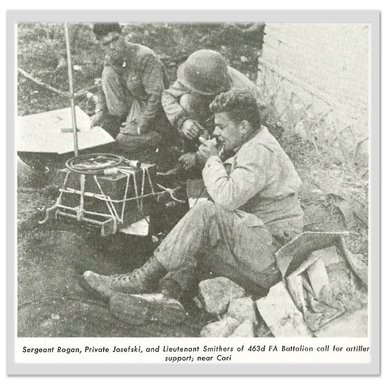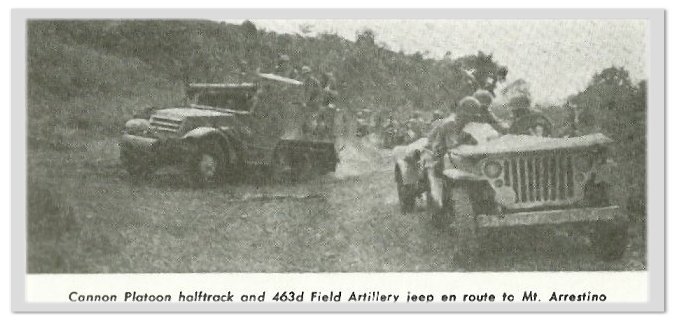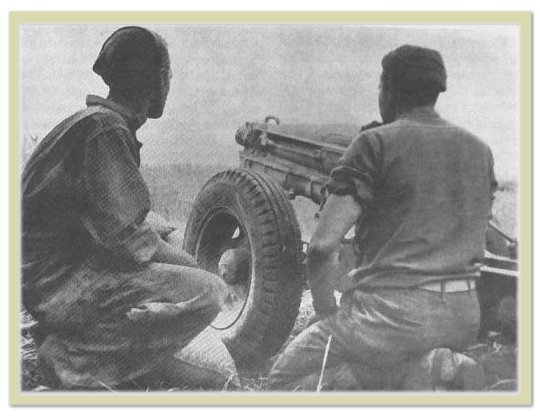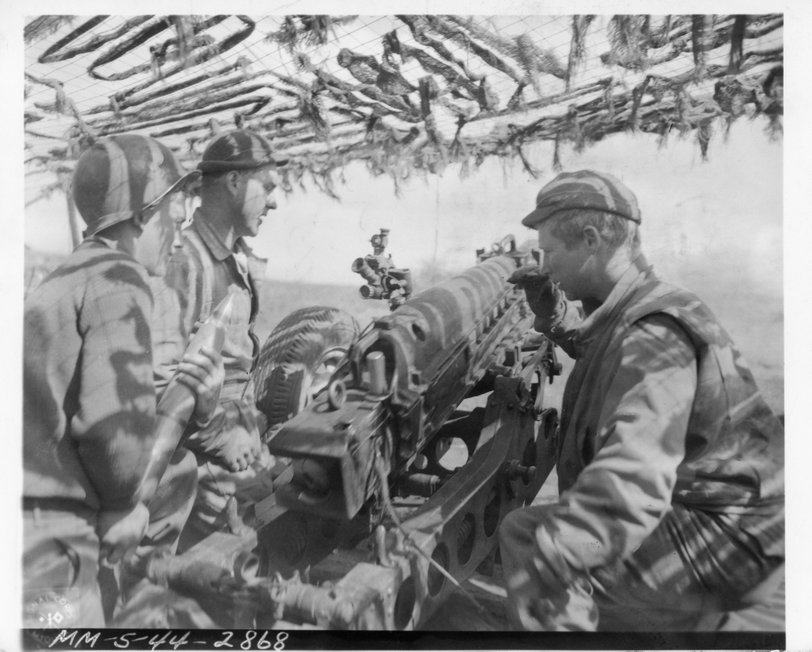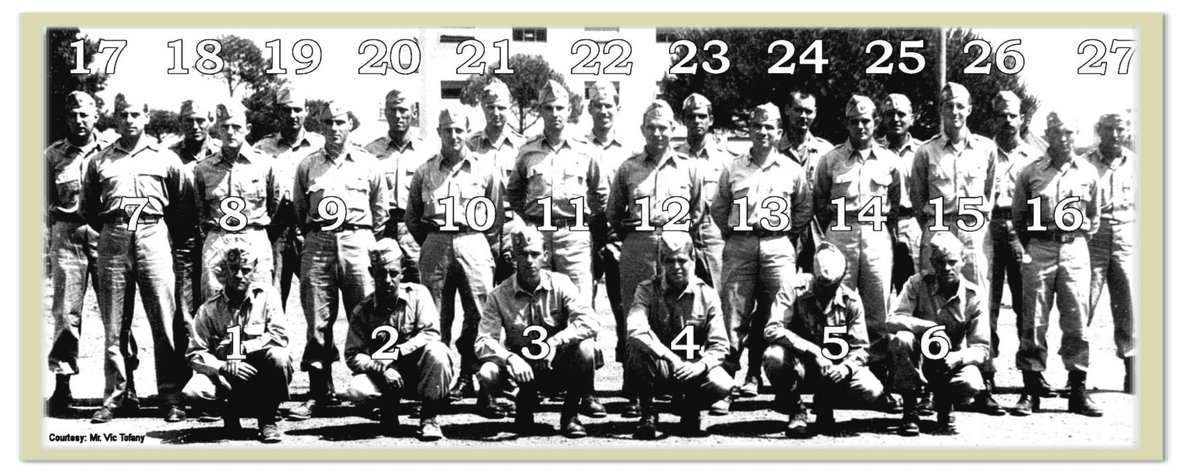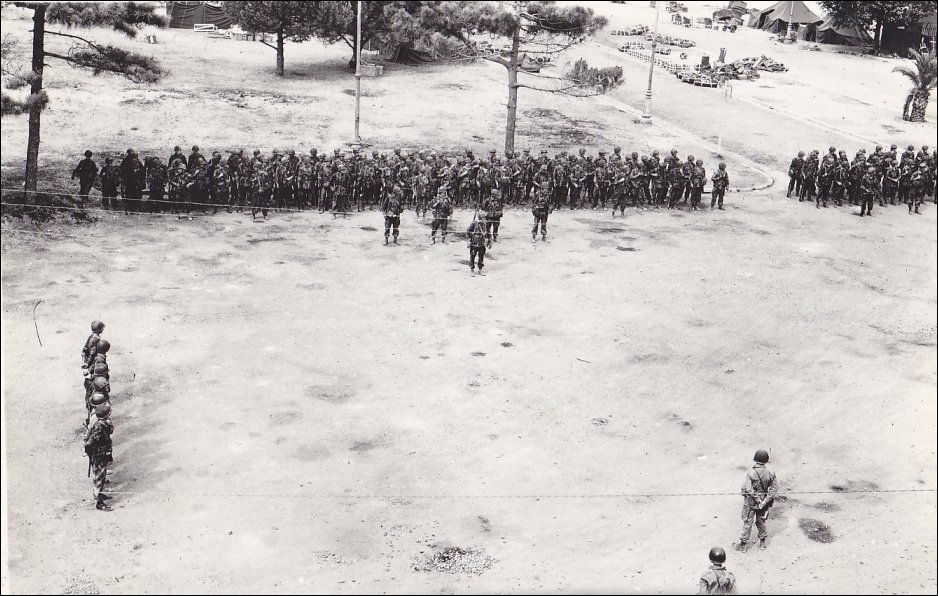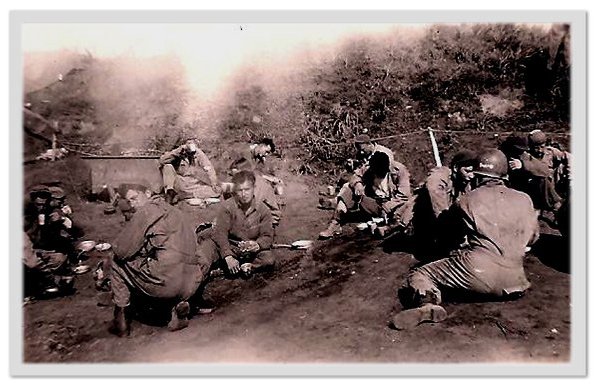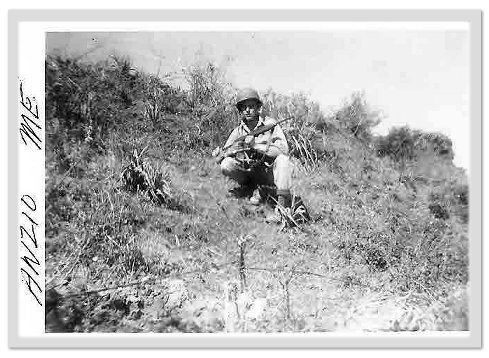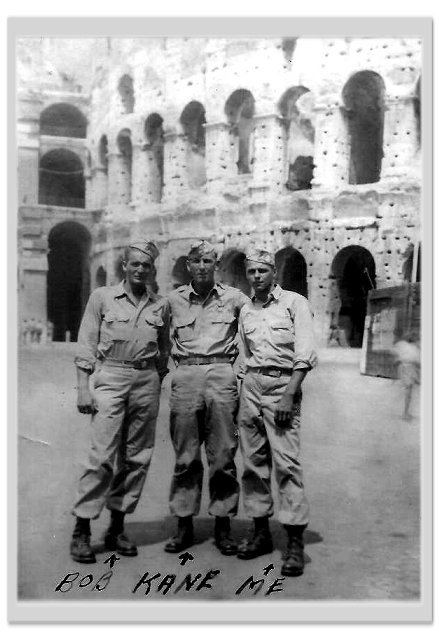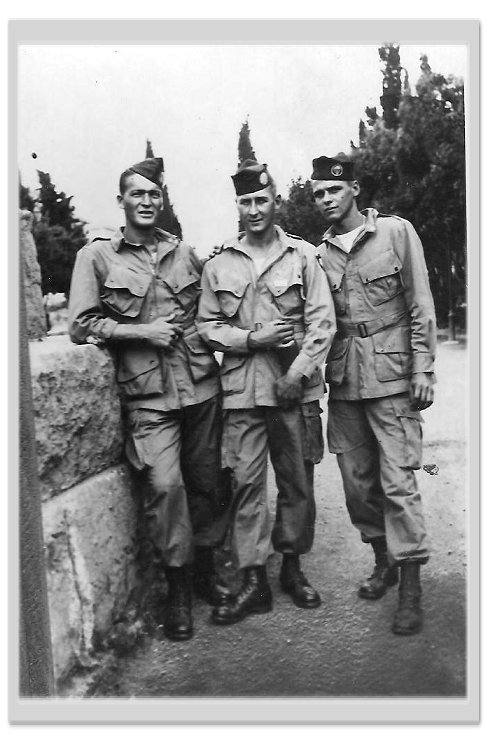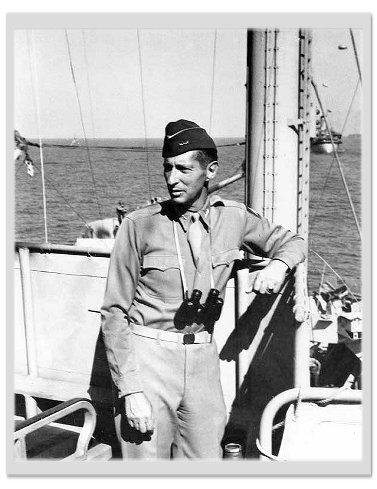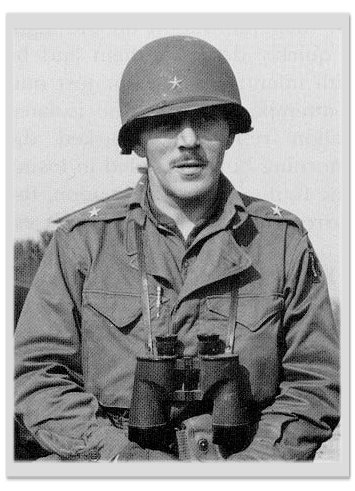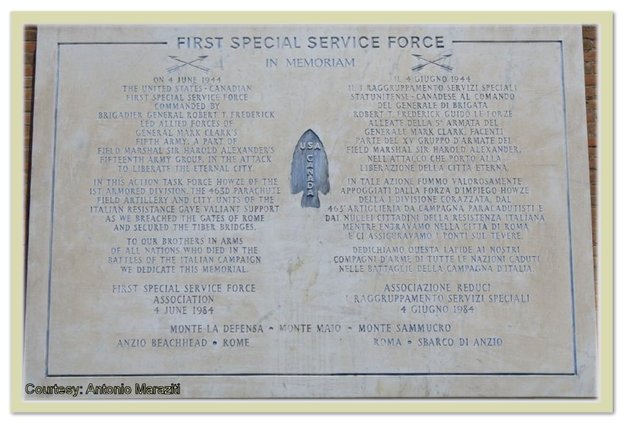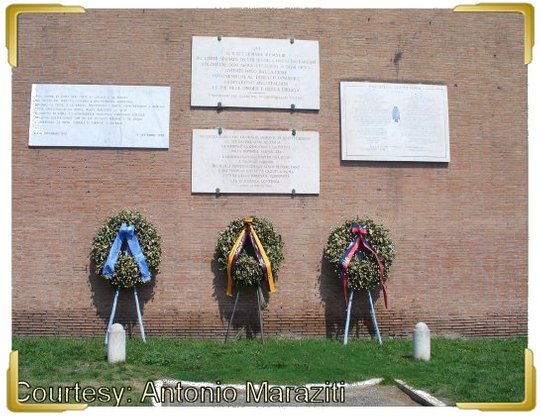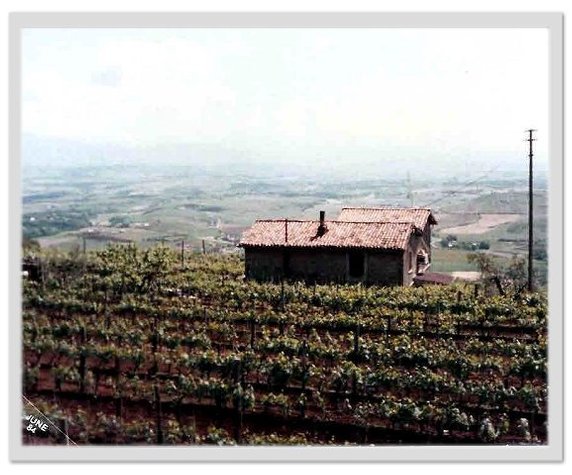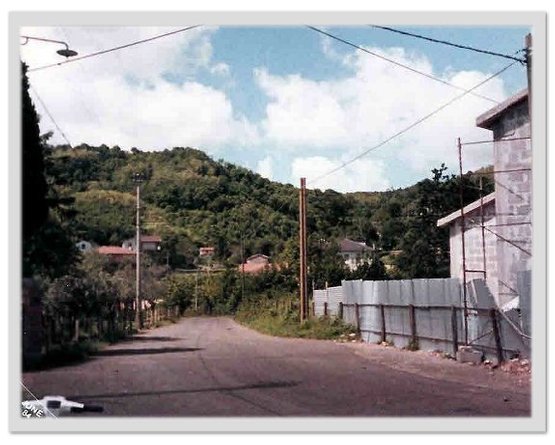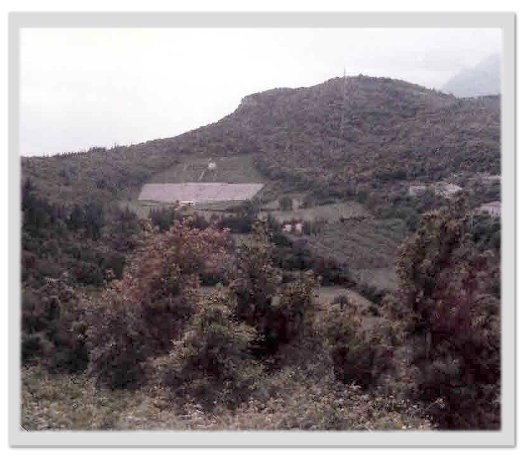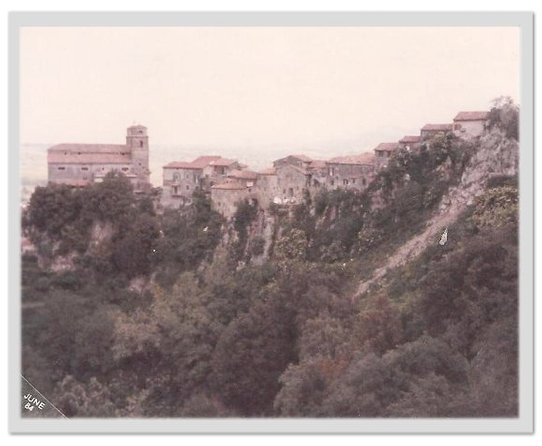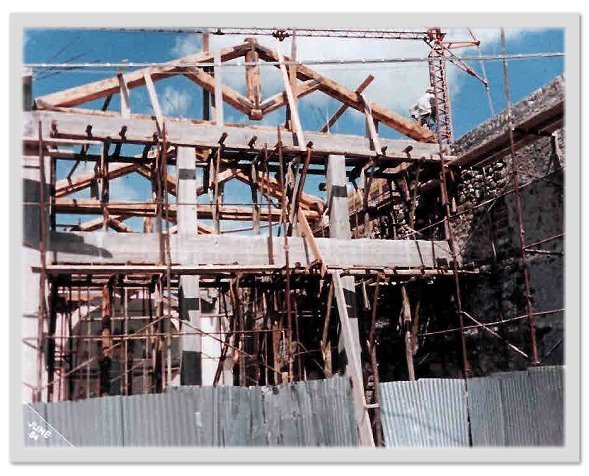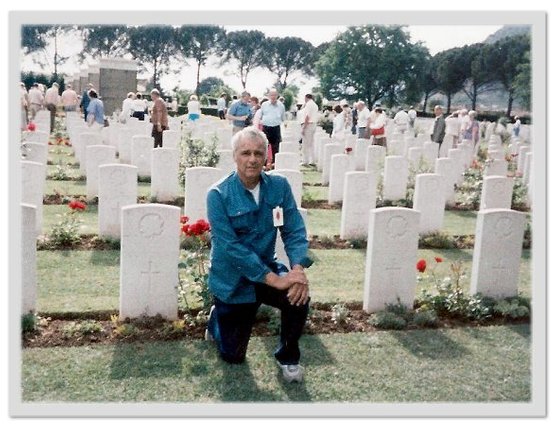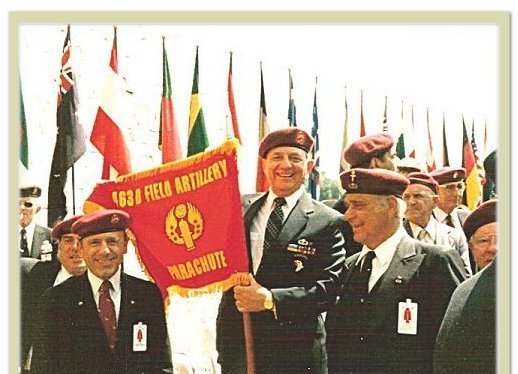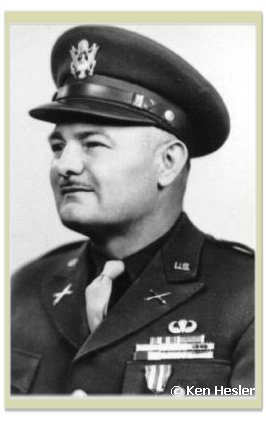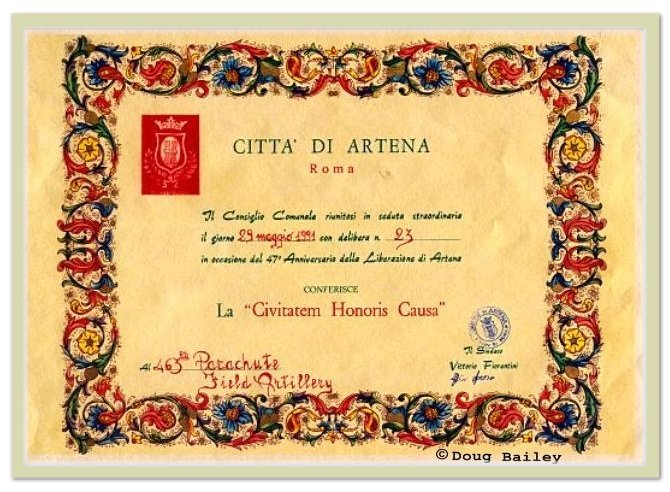The Italian Campaign
Credit
A lot of gratitude towards WW2 D Battery Mr. Ken HESLER for research and writing and Mr. Stuart SEATON for reviewing.
Introduction (456th and 463rd Parachute Field Artillery Battalions)
When Italy was invaded by Allied Forces on September 3, 1943, the 463rd Parachute Field Artillery Battalion did not exist. As a military unit, it never went overseas or returned to the States after World War II, being inactivated in Joigny, France, November 30, 1945. Yet, a majority of its soldiers served with the two premier airborne divisions of World War II; fought in seven major campaigns, including two airborne invasions; provided, as a separate battalion, artillery support for elite infantry and commando units; and earned a place in the military annals of World War II for it accomplishments.
All of this began when the 456th Parachute Field Artillery Battalion was activated in 1942 as the first parachute field artillery unit staffed largely with officers and men from the Parachute Test Battery that had developed a system of delivering 75mm howitzers to the battlefield by air. As part of Gen. Matthew B. Ridgeway’s 82nd Airborne Division, it participated in the July 1943 invasion of Sicily.
At the conclusion of that campaign in August 1943, circumstances intervened. First, Ridgeway’s 82nd Airborne Division, including the 456th, was assigned to Gen. Mark Clark’s Fifth Army, resulting in a disagreement between Ridgeway and Clark as to the final disposition of the Division’s forces. The 82nd was already slated for the Normandy invasion in 1944, but Clark sought the Division for use by his Fifth Army in Italy.
According to Clay Blair, author of “Ridgeway’s Paratroopers”, the conflict between Ridgeway and Clark “led to prolonged discussions at the highest levels in North Africa, London and Washington, which resulted in a compromise”.
Ridgeway’s 504th Parachute Infantry regiment, the 376th PFAB, and the 456th, would remain for an indefinite period under Clark’s command. The remainder of the 82nd would be transferred to the British Isles. By the end of September 1943, the first two were already in Italy, leaving the 456th to shuttle back and forth between Sicily and North Africa for training exercises after not being included in the 82nd’s invasion plans for Salerno.
According to a report presented to the Army Command and General Staff College at Fort Leavenworth, KS, in 2004, "The reason for not taking the 456th into combat on Salerno was due to an altercation between the division commander and the 456th battalion commander in one of the battles at Sicily… It came down to a difference in artillery philosophy between Ridgeway and Lt. Col. Harrison B. Harden, the 456th battalion commander". The result was Harden being relieved and replaced by Maj. Hugh A. Neal, who would command that unit until being seriously wounded at Anzio May 31, 1944.
After the war, Neal recalled that “Harden, Taylor, and Ridgeway had been at odds. Why? I am not sure that I know. But the feeling was not good at all”. Neal speculated "that Ridgeway, through Gen. Maxwell Taylor, his artillery commander, had simply used that opportunity to cut the battalion in two and get rid of Harden at the same time."
In mid-November 1943, the First Special Service Force, the “Devils Brigade,” a joint American-Canadian commando unit, arrived in Naples and was assigned to the 36th Infantry Division along the Cassino front. About five weeks later, the 456th,"less Batteries C and D, shipped from Bizerte, Tunisia, (arriving through the Port of Naples) and went into position near Ceppagna, Italy, in support of the Force", according to Lt. Col. John T. Cooper who had succeeded Maj. Neal as commanding officer.
Doug Bailey of “B” Battery, 456th, describes the Italian venture this way in his “Condensed and Unofficial History of the 463rd Parachute Battalion”:
"Landing at Naples (November 30, 1943), we marched to Bagnolia and then on to Santa Maria where we joined forces with the U.S. and Canadian First Special Service Force. Within a week we were up on the Cassino front. This was in December 1943, and we spent Christmas at the front up around Venafro. Little did we realize that a year later we would be spending another Christmas in the snows of Bastogne. Rain, snow, mud, mules and mountains - that's the story of the Cassino front. The only place during the whole war that the ground looked like pictures of No-man's land during the First World War with water filled shell holes, shattered trees and destroyed villages.”
Lt. Col. Robert D. Burhans in his book, “The First Special Service Force: A War History of the North Americans, 1942-1944”, notes the arrival of the 456th in Italy: “They were new to the Force then but would in the coming months become as closely attached in common experience as artillery could manage with infantry”. That close relationship of the 463rd and the Devils Brigade on Anzio would continue at Anzio and in Southern France . The FSSF was deactivated December 5, 1944.
Pictures above come from LTC R. Burhans's Book.
Referencing the ISBN number of
“The First Special Service Force: A War History of the North Americans, 1942-44”
by Lieutenant Colonel Robert D. Burhans,
published first in 1947 by the Infantry Journal Press and reprinted by The Battery Press, Nashville, TN, in 1996, it is ISBN 0-89839-261-6.
The 456th and the Force loaded on naval landing crafts near Naples at the ancient port city of Pozzuoli on January 31 and departed for the Anzio beachhead, landing the next day without incident. On February 2, both went into positions on the beachhead.
Burhans writes: “The Corps orders read: ‘First Special Service, with 456th Field Artillery Battalion (less Batteries C and D) attached, will relieve the 39th Engineer Combat Regiment night 2-3 February and defend right flank of VI Corps S of (Bridge 5)…' The Force had been fortunate in obtaining the attachment of the 456th Field Artillery Battalion which was also in support”. (Bridge 5 refers to a bridge across the Mussolini Canal and the right flank of VI Corps S that was along the Mussolini Canal.) As noted on the FSSF memorial in Rome, the men of the 456th/463rd and the Force would cross the bridges of the Eternal City together when that city fell on June 3, 1944.
At 1 p.m. February 20, 1944, on the Anzio Beachhead, 336 officers and men of the 456th Parachute Field Artillery Battalion were officially constituted as the 463rd Parachute Field Artillery Battalion that was activated on that date. The detached batteries (C and D) of the 456th would be reconstituted in the British Isles as the 456th Parachute Artillery Battalion. In late March 1944, the 504th Parachute Infantry Regiment and the 376th Parachute Field Artillery Battalion were withdrawn from combat at Anzio and shipped to the British Isles to rejoin the 82nd Airborne Division. The 456th designation went to England with the 82nd.
Thus, the 463rd left the ranks of the 82nd Airborne Division to become a “bastard battalion” providing artillery support for various elite airborne infantry units (First Special Service Force, 509th Parachute Infantry Battalion, and the 550th Airborne Infantry Battalion) during the Anzio and Southern France campaigns. In December 1944, it returned to the divisional fold with the 101st Airborne Division for the defense of Bastogne, remaining with the Screaming Eagles until the conclusion of World War II.
Epilogue
When the 463rd was inactivated November 30, 1945 in Joigny, France, those still on the battalion roster in the ETO completed the circle with their transfer back to the 82nd Airborne Division’s 456th Parachute Artillery Battalion. They returned to the States with the 82nd aboard the Queen Mary, sailing from Southampton, England, on December 28, 1945 and arriving in New York January 3, 1946.
Nine days later, they marched down New York City’s Fifth Avenue before more than a million spectators in the World War II Victory Parade, with the 82nd leading the way. A week later, the 82nd returned to Fort Bragg, NC, from where it had departed nearly three years earlier.
FROM THE TRADING POST MAGAZINE
Italian Campaign
Landing at Naples in mid-December 1943, the 456th marched to Santa Maria where it was attached to the Canadian American First Special Service Force (FSSF). For the next six months, the history of the 456th/463rd would be interwoven with that of the "Force." As expressed by one author and former member of the FSSF, "They were new to Force then but would in the coming months become as closely attached in common experience as artillery could manage with infantry."
The 456th joined the FSSF just before its assault on Hill 720, the western spur of Mt. Sammucro. This assault went in on Christmas Day of 1943 and was part of a general drive toward Cassino and the Gustav Line during which the role of the FSSF was to protect the right flank of the U.S. II Corps and secure the high ground covering an attack by the 1st Armored Division up Highway 6. Enemy resistance east of the Rapido River and the Gustav Line was largely broken by mid-January 1944.
Fifth Army had issued tentative orders reassigning the FSSF to II Corps for the impending assault-crossing of the Rapido River. For this crossing, the 456th was to be attached to the 36th Infantry Division. However, on the morning of 30 January 1944, both the 456th and the FSSF were unexpectedly ordered to Pozzuoli, a port staging area near Naples. At Pozzuoli, they were loaded on LCT's and LCI's, and at dusk they set sail. Their destination was the Anzio beachhead.
Anzio
Despite a bright moonlight night, enemy aircraft did not molest the convoy, and at daybreak it was anchored off the headlands of Anzio. By noon, the units had been unloaded and staged into an open field about two miles from the town.
On 2 February 1944, the FSSF with the 456th went into the line under VI Corps. The Corps order read: "First Special Service Force, with 456th Field Artillery Battalion (less Batteries C and D) attached, will relieve the 39th Engineer Combat Regiment night 2-3 February and defend right flank of VI Corps S of (Bridge 5) inclusive." The 39th Engineers had been in a defensive posture and were glad to turn over the area to their replacements.
The sector assigned to the Force extended about eight miles along the Mussolini Canal from Bridge 5 to the sea. This sector comprised about one fourth of the perimeter of the entire beachhead. However, despite the very thin spreading of troops - about one every twelve yards - and the much larger enemy formations arrayed in front of it, the Force and its supporting elements were a constant headache to the enemy through their effective fire and aggressive patrolling.
Picture:
463rd artillerymen near Cori, Italy.
Their "Pack 75" howitzer weighed only 1,268 pounds,
and it could be disassembled for airdropping.
However, its range with a 75mm projectile was only 9,475 yards
compared with 12,330 yards for the Standard howitzer
which fired a 105mm projectile.
Clearing away the resistance around Artena and Valmontone to the north was not completed until about 2 June and required heavy support from II Corps. Until the last elements of the German Tenth Army had passed through Valmontone enroute to Rome and beyond, the enemy resisted the cutting of Highway 6 with every possible means. During the ensuing attack on Valmontone by the 3rd Division on 1 June, the FSSF with the 463rd and its other elements had the job of securing the division's right flank
Fifth Army was now ready to commence its drive on Rome. With a front comprised of three corps, it planned to pursue the fleeing enemy through The Eternal City before he could reorganize on another line. To lead the assault, II Corps attached Task Force Howze to the FSSF effective 3 June. This Task Force was an armored group comprising elements of the 81st Reconnaissance Battalion and the 13th Armored Infantry under command of Colonel Howze. It was planned that the FSSF and Task Force Howze would alternate in the advance, with the armored elements driving ahead during the day while the FSSF advanced the point at night. With an enthusiasm akin to gold-rush fever, the units set out at top speed. By 1945 hours on the evening of 3 June, Task Force Howze had advanced fifteen miles from Valmontone and pulled up to let the FSSF take the night advance. By midnight the Force had reached Tor Sapienza, a suburb of Rome. At 0106 hours on 4 June the Force received orders to secure the six bridges over the Tiber River to the north of Vatican City. The combined force moved forward at daylight and entered the city limits at 0620 hours, coming under fire almost immediately from antitank guns. It was 2300 hours that evening before the Force had secured a total of eight bridges over the Tiber.
In commemoration of their achievement, a plaque was ceremonially placed on St. Paul's Gate In the middle of Rome on 4 June 1984 - the 40th anniversary of its liberation. The inscription on the plaque reads as follows:
First Special Service Force
In Memoriam
On 4 June 1944, the United States-Canadian First Special Service Force commanded by
Brigadier General Robert T. Frederick led Allied Forces of General Mark Clark's Fifth Army,
apart of Field Marshal Sir Harold Alexander's Fifteenth Army Group,
in the attack to liberate The Eternal City. In this action Task Force Howze of the 1st Armored Division,
the 463d Parachute Field Artillery and city units of the Italian Resistance gave valiant support
as we breached the gates of Rome and secured the Tiber bridges.
To our brothers in arms of all nations who died in the battles of the Italian Campaign
we dedicate this memorial.
First Special Service Force Association
4 June 1984
Monte La Defensa - Monte Majo - Monte Sammucro
Anzio Beachhead - Rome
Through 5 June the FSSF, with the 463rd, assembled in the area of Tor Sapienza. The following day, they were relieved from combat and placed in Fifth Army reserve for a much needed rest and recuperation. For this, the units were moved to Lake Albano, about seven miles southeast of Rome and west of the Alban Hills. Here the Vatican summer palace overlooked black volcanic beaches which ringed the blue waters of the lake. Liberal passes into Rome were interspersed with a program for reequipping and retraining.
The FSSF and the 463rd parted company on 1 July 1944 when the Force was moved to a training area south of Salerno (the two units were to meet again in France). The 463rd remained at the lake until 15 July when it was moved by truck to Lido de Roma where training continued in preparation for the invasion of Southern France. Batteries C and D of the 463rd (originally transferred to England during the reorganization at Anzio) were activated on 21 July 1944.
A Condensed Chronology, by Martin GRAHAM
Based in large part on a collection of archival documents and other materials,
acquired and provided by Ken Hesler, Battery D, 463rd PFA.
November 1943
Nov. 30 | Boat | Naples, Italy
Batteries A & B & Hq docked at Naples at 11:00AM. Debarked at 11:30AM and marched to bivouac area 5 miles North of Naples at Bagnoli, Italy, arriving at 5:00PM.
Arrived at 10:00AM
Nov. 30 | March | Bagnoli, Italy
Doug Bailey:
Came through the straits of Messina OK. No sign of enemy planes. Pulled into harbor at Naples. Lots of ships sunk in harbor. Had long march to quarters, staying in some Italian college buildings (Victor Emmanuel College)
December 1943
Dec | Truck | Caserta, Italy
Dec. 1
Doug Bailey
Christmas package from home.
Dec. 5
Doug Bailey
Went into Naples without pass. Pretty interesting place. On guard tonight.
Dec. 8
Doug Bailey:
Went to Naples with Datoli. Walked all over. Talked to some survivors of 16 merchant ships that were sunk in the Atlantic. They told us there were lots of ships in the Harbor at Barry, including ammunition ships when some Faulk Wolf fighter bombers that had twin tails and were mistaken for out own twin tail P-38s. Got in close and bombed heck out of them.
Dec. 9
Doug Bailey
Advanced detail left this morning for someplace.
Dec. 13
Departed Bagnoli by vehicle by echelon starting at 6:00AM.
Doug Bailey:
Now about 30 miles from Naples at Italian Army Garrison with the Canadian/American First Special Service Force. Living in bombed out buildings. Allied planes going back and forth all day to the front lines. This was our first meeting of the Canadian/American First Special Service Force. We would be with them quite some time.
Dec. 14 | Truck | Santa Maria, Italy
Closed in bivouac area 1 mile Northwest of Santa Maria at 11:00AM.
Attached to the First Special Service Force, known to the Germans as the "Black Devils". Gen. Frederick had stickers printed with "The Worst is Yet to Come" in German which were pasted on the foreheads of Germans killed during patrols. (Rome '44, Trevelyan, pg. 193)
Dec. 21 | Truck | Venafro, Italy
Doug Bailey:
Rain, snow, mud, mules & mountains was the story of Cassino front. Water filled shell holes, trees shattered, and destroyed villages. Took hot shower and got clean underwear. Cleaned gun and loaded in trailer. Getting ready to move up again.
Dec. 22 | Truck | Ceppagna, Italy
Departed Santa Maria area by vehicle at 4:00PM. Arrived in position at Ceppagna at 7:00PM.
Doug Bailey:
Still by San Vittore (del Lazio). Got haircut from kid about 12 years old in bombed out town. On 4 hour guard last night but nobody woke me up. So didn't stand guard. Don't think the guy I was suppose to relieve could find my hole. Gun all dug in and camouflaged. Did not do a hell of a lot of firing. Moved back by jeep and trailer to San Vittore for a rest.
Dec. 23 | Mt. Sammucro (Monte Sambùcaro)
John Cooper:
Went into position near Ceppagna in support of First Special Service Force. Due to heavy snow and general inclement weather, operations were static during the period that this unit was on the Italian southern front. Heavy artillery fire going in both directions was the usual order of things.
Doug Bailey:
Heard of Allied landings below Rome. Moved up to new positions on side of hill. Raining like heck. While digging gun pit came across old Roman road. Did a lot of firing. German planes diving on our positions on other side of hill. Kitchen tent burnt down. Moore got hand burnt.
Dec. 25
Joined in assault on Hill 720 (Western spur of Mt. Sammucro) on Christmas Day.
Doug Bailey:
Christmas at the front. Pulled in last night. Dug gun in. Wet and muddy. Saw Bill Faires and Norm Svela. They are in little town close by. We moved up at night, and when morning came found out we were in a really bad exposed position on this hillside. We could see Casino and the Abbey in front of us. I think this is why we did not stay in this position very long. That night the rain was really coming down and I was on guard out in front of position and noticed a long line of guys coming down past me. I asked, "What outfit you guys in?" It was the Japanese 100th Battalion, later to be part of the Japanese 442nd Regimental Combat Team.
Dec. 28
Casualties
T/5 Daniel Torrieri WIA
January 1944
Jan. 3
Doug Bailey:
Saw our plane dive bomb German position. Went about 25 miles back of front to take shower. On way back to front, German planes strafed us. Trucks stopped. I jumped out over tailgate and dove under motor of truck behind us. Green Eyes (Bennett) dove in ditch full of water. So did Powers. Planes came back about 2:00PM. Two of them shot down. Came during fire mission. Everybody hit the dirt. They killed about 20 men and left 3 trucks burning on the road.
Jan. 4
Doug Bailey:
Still at front. We are dug in on side of hill and close by there was a pile of dead Germans that were piled up like a stack of wood and frozen stiff.
Jan. 5
Doug Bailey:
Watched our planes dive bomb German positions. Big battle going on all night. Sky was all lit up. Dead German wrapped in shelter half close to position. Lots of rain.
Jan. 6
Doug Bailey:
Enemy planes overhead. AA drove them away. Germans shelling town and hill about a mile away. Our planes dive bombing Germans. Mortar shelling in close by the Germans. Now have slit trench with roof.
Jan. 7 | Truck | San Vittore (San Victoria), Italy
Departed positions area at Ceppagna by vehicle by echelon at 7:30PM.
Arrived in position area 1/2 mile East of San Vittore at 9:30PM.
Casualties:
Pvt. Wendell D. Gillman WIA - LW - Leg
Jan. 8
Doug Bailey:
German planes overhead nearly all day. Moving up tonight.
Casualties:
Pfc. John Rimm DOW
Jan. 9
Doug Bailey:
Moved up to the front last night. Dug gun in. Five of us came up late. Driver got lost on the way up. After digging in, dug slit trenches. It is raining very hard. A few enemy shells bursting near. Finished slit trench and had some fire missions.
Jan. 11
Doug Bailey
Firing at the Germans. Shell landed right in front of our gun. A dud. It was in this position when we first heard the German Nebelwerfer (Screaming Meemie) a six barrel rocket gun that made such a horrible screech.
Jan. 13
Casualties:
Pvt. Francis Kane WIA - SFW - Back
Doug Bailey
German planes came over while eating breakfast. Everybody scattered. Spitfires chasing Germans. Our AA shooting at the Spitfires. Shelled German dug out with good effect. B-25 received direct hit from German AA. Burst into flames.
Jan. 15
Casualties:
Pvt. George M. Akin WIA - LW - Hand & Leg
Pfc. Wayne L. McKenzie WIA
Jan. 16
Departed positions area San Vittore by vehicle in echelon at 2:30PM. Arrived in position area on Southeast edge of Cervaro at 5:30PM.
Doug Bailey:
Fired all night. Heard that Rezor from HQ had foot blown off by German mine while laying wire.
Casualties:
Pvt. Nicholas Rezor WIA - foot blown off
Jan. 17 | Truck | Cassino, Italy
Finally relieved after months of rain, snow, and mountains. Water-filled foxholes and gun pits.
Doug Bailey:
Fired all night. Germans shelling us with mortars. Took compass reading on them and fired corps 5 rounds. Today saw German fighter plane blow up over gun position. Spitfire shot it down. It was a German ME 109.
Jan. 17 | Truck | Santa Maria, Italy
Jan. 18
Departed position area Cervaro by vehicle by echelon at 7:00PM.
Jan. 19
Arrived positions area 2 miles Northwest of Cervaro at 4:00AM.
Doug Bailey:
In position on outskirts of Cervaro. Moved in two nights ago. Dug gun in. Fired very little. Now waiting to move a couple miles toward Casino. Germans shelling close. S---- had a nervous breakdown and sent to rear. Enemy planes overhead every day. Moving up tonight.
Jan. 20
Departed position area Cervaro by vehicle by echelon at 3:30PM. Arrived bivouac area 1 mile East of San Vittore at 8:00PM.
Jan. 24
Doug Bailey:
Germans shelling pretty close. Moved back to fox hole to sleep. We were attached to the First Special Service Force, then the 36th Division and now attached to the 91st Recon outfit. Still wet.
Casualties:
T/4 Robert T. Hambright WIA - CW - Nose
Jan. 25
Doug Bailey:
Moved up a railroad bed that was being used as a road pretty close to front. Germans shelled heck out of our old area about 10 minutes after we left. Direct hit where no. 2 gun position was. Crashed P-38 out in front of our position.
Jan. 26
Departed bivouac area San Vittore at 12:00PM.
Arrived position area 2 miles Southwest of San Vittore at 2:30PM.
Jan. 26-27-28
Doug Bailey:
All dug in at new position. Doing most of our firing at night.
German shells landing close. A few guys get to go back to a rest camp for a few days.
Jan. 30
Departed position area San Vittore by vehicle at 9:00AM and arrived at bivouac area 11/2 miles North of Santa Maria at 2:30PM.
Departed at 8:00PM by vehicle.
Jan. 31
Arrived outskirts of Pozzuoli, Italy by vehicle and foot at 11:30AM. Arrived at the landing at Pozzuoli at 1:30PM. Boarded British LST's at 2:30PM and departed for the 100 mile trip to Anzio at 6:00PM.
Loaded on LCT's and LCI's and left for Anzio on January 31, 1944.
Doug Bailey:
Heard rumor that we would take off in morning. It came true. Packed gun and went back to base camp at Santa Maria. First Special Service Force all ready to go. Pulled out and spent night in a staging area. Marched to docks. Got to see Bill and Norm (two guys from my home town) in staging area. Rags hit guy that was pestering Major Wicks. Boarded a LST. Had shower on board and good chow. Even got a bunk. Pulled out and don't know where we are going.
GENERAL NOTES ABOUT CASSINO
When troopers released from hospital, they were put into pool and sent to any unit needing reinforcements. If wanted to return to original unit, had to go AWOL, find their units and report. Unit had to place them back on rolls even though they realized they were AWOL.
Stuart Seaton (tape)
Spent a week as a forward observer on a hill near Monte Cassino and witnessed the bombing of the abbey. Afternoon of the day of the disastrous crossing of the Rapido River by the 36th Infantry Division and Texas National Guard, Neal took Seaton and some other officers on a reconnaissance because of the plan to attempt another crossing the next day. Seaton remembers a deadly silence while driving in the jeep. All he saw were medics with big Red Cross banners. The absence of noise was unusual for Italy which was always a mass of noises. Stuart mentioned this to Neal who said the Germans had permitted an hour moratorium to cross the Rapido and remove the dead and wounded.
Al Mury (tape)
"During the Cassino campaign, the 456th was the most ill-equipped unit for fighting that God ever created." On Hill 1205, had very poor equipment. No decent boots or coats. Mury got trench foot. On Mt. Trocchio, the trail to the summit was a nightmare, heavily mined. Had to follow the tape guides very carefully. Mury heard explosions and men scream when they stepped on mines.
Claude Smith (tape) of Baker Battery
was going to put a shell into the abbey at Monte Cassino but was told anyone doing that would be court-martialed. Screaming meemies were coming in about every 5 minutes, so Smith would time the shots and jump in the foxhole just before the shells arrived. He thought he spotted the gun and called the position in. 2,700 guns opened up on the position. About an hour later the enemy shells began coming in gain.
August Hazzard (tape)
On Hill 1205, used mules to go up and down the hill. Hazzard laid wire to OP back and forth. Forward observers under Lt. Shephard. There was a mine field in front of 1205. Two Germans became trapped in the field when they exploded mines. Every time they moved they set off more mines. They laid and moaned all day until night when the moaning finally ended. This was the one incident from the war that stands out in Hazzard's mind. (Joe Lyons state those 2 bodies froze and Ben Wright propped them up in front of the OP and said they were his guards.) Hazzard remembers mud, rain, and slush during the campaign. They were moving all the time. He observed French Goumier troops from Morocco who would cut off their victim's ears. They would come back at night and come extremely close to you without your knowing it.
Jay Karp (tape)
On OP on hill 1205. Dead German was in front of OP. (refer to Hazzard tape) One night when he was relieved along with another guy, they started down the hill, but got lost. They weren't sure if they were headed toward allied or enemy positions. They split up so at least one of them would reach headquarters. Jay sat down behind a ledge until daylight and then finished the journey down.
When moving beyond the Rapido River, Jay Karp passed over where the 34th Division had been slaughtered. All bodies still in holes, bodies blown apart. He was later on a gun section by the abbey. They received a lot of enemy counter fire. He dove for a lot of holes. German rockets were fired at them. On one occasion, Jay shared a hole with John Cunius. When they heard a German incoming shell, they dove into a hole and the shell hit about 2 feet away. They thought it was an on-time fuse, but after 10 minutes they came out of the hole to find it was a dud. There were a lot of duds in Italy.
Tony Spagnol
"In Italy the 456 supported the 505 PIR and the First Special Service Force in battles near Santa Maria and continued support up to the Cassino front. I was assigned as a cannoneer, substitute radio operator and any open area where anyone needed help."
Doug Bailey:
Rain, snow, mud, mules and mountains - that's the story of the Casino front. The only place during the whole war that the ground looked like pictures of No-Mans land during the first World War with water filled shell holes, trees shattered and destroyed villages. After a few weeks on the Casino front, we pulled out and headed back to Naples. We thought we were going to get a rest. Little did we realize that the next day we would load on naval landing ships to be fed into the meat grinder that became the Anzio beachhead.
February 1944
A Battery, far left is Mr. Richard A. CARROLL
22 MAR 44 [MM-5-44-2868]
Fifth Army Mussolini Canal. Men of the 463rd Para Field Art. firing the 75mm Pack Howitzer on enemy positions. Photo by U.S.Army Sig C.
Courtesy National Archives,
photo no. 111-SC-312786
Feb. 1
Debarked at Anzio at 8:30AM. Marched on foot to troop concentration area 11/2 miles Northeast of Anzio, arriving at 10:00AM (2 miles).
Doug Bailey:
Spent good night on LST. Landed on new beachhead at Anzio. Saw spitfire on fire. Pilot bailed out and landed in the ocean. Plane crashed in the sea. Destroyer picked up pilot.
Feb. 2 | Boat
Anzio, Italy/Gustav Line
Departed concentration area Anzio by vehicle at 8:00AM. Arrived bivouac area 4 miles North of Anzio at 9:00AM (3 miles). Departed bivouac area by convoy at 7:00PM. Arrived position area 1/2 miles Southeast of Borgo Bainsizza at 8:00PM (4 miles).
First Special Service Force, with 456th (less Batteries C & D), relieved the 39th Engineer Combat Regiment to defend right flank of VI Corps S at Bridge 5. The sector stretched about 8 miles along Mussolini Canal from Bridge 5 to sea (1/4th of beachhead).
Batteries C and D and the designation 456th PFA were officially assigned to the 82nd Airborne Division in England. Neal was incensed at the "rape of the battalion" (Blair, page 192) Lived on Anzio like moles. Foxholes and slit trenches dug into sides of canals and irrigation ditches. Shelling/counter shelling. Enemy bomber attacks at night and fighter planes strafing during the day. Enemy ground attacks during the day and night.
John Cooper:
During the first days of the battalions stay on the beach-head the enemy made repeated efforts to shove all the troops in the ten mile square back into the sea. These efforts were usually in the form of concentrated Infantry attacks supported by heavy artillery fire.
Doug Bailey:
Still in position. Germans shelled us yesterday. Used a little time fire. Shells hitting close.
Feb. 3
Casualties:
2/Lt. John C. Millard WIA - LW - Arm
Feb. 5, 1944 | Anzio
Three officers (who had been relieved from direct command due to there plotting against Neal) were in the Command Post with Cooper and 8 enlisted men. A 170mm howitzer shell passed to the right of Cooper and exploded in room with Capt. Joseph Harris, Battalion S-2, Lt. William Sparks, Assistant S-2, and Lt. Herbert Wicks, Battalion Executive Officer. Harris and Sparks killed along with enlisted man and Cooper pulled Wicks from the wreckage. Cooper became Executive Officer. Due to officer shortage, NCO's placed in positions normally held by officers. In four day period between February 16th and 19th, the eight howitzers from the two active batteries averaged over 1,200 rounds a day against counterattacks which usually lasted an hour each.
Casualties:
Capt. Joseph D. Harris DOW
1st Lt. William N. Sparkes KIA
1st Lt. John B. Higdon KIA
1st Lt. Herbert Wicks WIA
Maj. John T. Cooper WIA - CW - Back
M/Sgt. Noah D. Gray WIA - MW - Face
Tec 4 Merwin L. Sandlin WIA
Cpl. Emmette W. Gordon WIA - CW - Head & LW - Finger
Cpl. Paul E. Robin WIA - LW - Arm & Back
Pfc. Alex P. Miller WIA - LW - Head
Pfc. William L. Justice WIA - CW - Leg
Feb. 6
Doug Bailey:
Shell hit CP. Killed Capt. Harris, a couple of others, and one or two were wounded. German planes over today. Saw one crash. Two of them flew over us real close. Both smoking. Last night shelled German gun that was in cemetery. Germans counter attacked but failed. Fighting around a canal over here. I believe Cooper was in the building when the shell hit. I heard that this farmhouse had a Navy radio team in it with a high powered radio that was directing fire for warships off shore, and that the enemy radio direction finder zeroed in on it.
Feb. 7
Casualties:
Pvt. Jeff N. Dyer WIA - LW - Wrist
Doug Bailey:
Up all night last night. Expected Germans to counter attack, but they didn't. Fired time delay and HE at them on different sectors. Cold as hell last night. 20 Jerry's over today attack ships in the harbor. Think two of them shot down.
Feb. 8
Doug Bailey:
Germans again bombed harbor. Our bombers overhead headed north. Plane drops emergency gas tank real close. Think it was one of ours. Shelled house today. Delayed fuse. Germans ran out. Use time fire and got em.
Feb. 9
Casualties:
Sgt. Joseph F. Rogan, Jr. WIA
Feb. 10
Doug Bailey:
B-17 group going over to bomb German positions. One received direct hit from German AA fire. Went down in balls of fire. Another circled two men bailed out. Plane circled again and then went into dive. Crashed. I think 7 men got out of this one.
Feb. 11
Doug Bailey:
Got rained out of hole. Pitched tent. Ammo cases floating down ditch.
Feb. 12
Doug Bailey:
Germans dive bombing harbor.
Feb. 13
Doug Bailey
Same old stuff. Germans over at night bombing harbor. Saw three shot down. Olivant and myself went out at night to dig bazooka position. We didn't get much done. It was raining like heck and the L shaped trench was full of water. There we were up to our knees in water and miserable as heck. So, we started singing some crazy song.
Feb. 15
Doug Bailey
Took shower back at the beachhead. I think its safer up on the front.
Casualties:
1st Lt. Orval K. Sheppard WIA - LW - Arm
Feb. 16, 1944 | Borgo Bainsizza, Italy
By General Order No. 20, Headquarters, 5th Army, the 456th PFAB, less personnel and equipment, was transferred to the European Theater of Operations. In the same order, the 463rd PFAB (less C & D) was organized with the personnel and equipment of the the 456th PFAB. At the same time the Battalion was required to furnish a cadre of 6 officers and 61 enlisted men. This seriously affected their fighting strength.
John Cooper:
In the four day period, between 16 February 1944 and 19 February 1944, the right howitzers from the two active firing batteries averaged over one thousand two hundred (1200) a day against counterattacks which usually lasted about an hour each.
Doug Bailey:
Germans over in force last night. Raided harbor and our positions. Dropped flares. Bombs all around us. Big attack going on. Fired a lot this morning. Two ME 109s tried to shoot down our cub observation plane. Missed him. Germans shelling road close by.
Feb. 17
Doug Bailey:
German planes tried to get Cub again. It flew around the Church and big trees and got away. Saw our B-25s bomb German positions. Germans over bombing harbor again. Germans expected to attack again. We are ready for them.
Feb. 18
Doug Bailey:
Saw 3 B-24s go down in flames over German territory. About 300 B-24s in raid. Saw two make force landing on our side of the lines. One plane was disabled. Crew jumped. Empty plane flew overhead and over German lines. In a big circle, German AA missed it. Plane flew back over our lines and crashed near Nettuno. German counterattack last night. Fired like hell and beat it off. Got some tanks. Germans sent in wrecker tank to get 2 disabled tanks and we got it too.
Feb. 19
Doug Bailey
Germans attacked again and driven back by artillery and small arms fire. Germans bomb ships in harbor about 3 times a day.
Casualties:
Pvt. Hubert M. Mullin WIA
Feb. 20 | Borgo Bainsizza, Italy
1/2 mile southeast (1SSF map 168/169). Batteries A and B were re-designated the 463rd Parachute Field Artillery Battalion at a location near the Mussolini Canal, about one half mile southeast. Assigned to Fifth Army and attached to the VI'th Corps. Hugh A. Neal assigned as battalion commander. Six officers and 60 men from this unit rejoined the 456th in England several weeks later. The Germans nicknamed the 463rd the "Whispering Death Automatic Machine" due to the effectiveness of fire. Captured Germans thought the fire came from some special machine.
John Cooper & Fred Shelton
The quiet flight of the 75MM howitzer shell going through the air to its target. It had a quiet whispering sound, and it was on the target before you knew it was there. The Germans began to know and call this shell as "The Whispering Death."
Officers Enlisted
Hq 17 97
A 4 99
B 4 104
Med 2 9
TOTAL 27 309
Doug Bailey:
German shells landing close. German bombers came over in the evening and dropped radio controlled rocket bombs at ships in the harbor.
Feb. 21
Doug Bailey:
Same old stuff. Enemy planes over so low could have thrown rocks at em. Saw one go down about 2 blocks from our position.
Feb. 22, 1944 | Borgo Bainsizza, Italy
Doug Bailey:
Enemy planes over last night. Bombed hell out of harbor. Hit ammo dump or gas dump. AA shell hit about 10ft. from gun position. Shook us up a little. Found some foil that the Germans drop to foul up the radar net. German shells again landing close. Ragsdale to hospital (Tonsils). [He was wounded at Bastogne and later killed when the ambulance taking the wounded to the rear was ambushed and shot up.] Got 14 new men. Part of the outfit going to England. Germans had another big attack. Fired a heck of a lot. Fired bell out of gun. Part of gun blew off. Nobody hurt, lucky. Rained a lot but hole is ok. Eating C and K rations.
Casualties:
1st Lt. Roman W. Maire WIA
Feb. 24
Casualties:
T/5 William E. Gibson WIA - LW - Arm
Feb. 27 | Borgo Bainsizza, Italy
Battalion officially credited with stopping an attack on a 700 yard front, aimed at cutting the friendly lines and recapturing the natural fortifications along the canal, by firing 1,782 rounds in a little more than an hours time. During the action, S/Sgt. Robert Donahue and Pvt. Raymond R. Rogers crawled 500 yard through constant enemy artillery shelling to repair communication lines. This action allowed artillery to mass fire, causing many enemy casualties. 2 tanks disabled by direct hits, enemy gun battery neutralized, and 3 self propelled guns forced to withdraw.
Headquarters Battery and A Battery machine gun sections were also officially credited with knocking down one enemy plane each, after remaining by their guns and continuing firing while the area was being strafed.
Feb. 29 | Borgo Bainsizza, Italy
Monthly Report - From Feb. 20 to 29, expended 6,857 rounds and destroyed or disabled 7 tanks, 9 self-propelled guns and neutralized 3 gun batteries.
Casualties:
Pfc. Warren J. Willcox WIA - LW - Scalp, Fractured Teeth
S/Sgt. Charles E. Green MIA
Officers Enlisted
Hq 16 109
A 3 100
B 3 104
Med 2 8
TOTAL 24 321
March 1944
March 1 | Borgo Bainsizza, Italy
John Cooper:
Less and less German activity noticed in the sector. It became necessary for forward observation parties to conduct daily patrols in order to pick up targets. A Battery's observer sighted a large enemy unit assembling for an attack. Calling for fire, he completely encircled the enemy by skillfully adjusting fire and the entire group of 167 men walked one thousand yards to surrender. This was the largest enemy catch in Italy, up to this time. On being questioned by infantry intelligence officers, they stated that the artillery in this sector was so terrible that they feared to move at all, during the day. On numerous occasions during the time on Anzio, Battalion reconnaissance officers personally controlled rolling barrages in front of enemy infantry attacks, by advancing with the infantry scouts and keeping the barrage in as close as possible, often less than 100 yards.
March 2 | Borgo Bainsizza, Italy
Gus Hazzard:
U.S. bombers bombed enemy position. 3 B-17's shot down. Witnessed 10 G.I.'s bailing out. Bob Bolen and Fred Bock stole a cow & horse & brought them back to Btry. A. Dressed oxen out, "tough as leather." Sergeant Green went on patrol with the FSSF and was captured.
Casualties:
Sgt. Green MIA
March 10
Casualties:
1/Lt. Victor J. Tofany WIA when 88 shell landed next to him. Not hospitalized.
Pfc. Alfred J. Pierce WIA
March 20
Casualties:
Pfc. Harold B. True WIA
March 26
4 additional howitzers obtained. Battalion now has 2 six-howitzer batteries.
Casualties:
Pfc. Lark A. Erskine WIA
March 29, 1944
Casualties:
Pvt. Richard M. Sullivan WIA
March 31 | Borgo Bainsizza, Italy
Monthly Report - During month, battalion fired 13,000 rounds, destroying 3 tanks, 5 vehicles, 4 mortars, 10 dugouts, 2 pill boxes, 7 gun positions.
Targets were: Personnel - 149; guns - 33; and tanks & SP's - 18.
Officers Enlisted
Hq 16 143
A 4 77
B 3 78
Med 2 9
TOTAL 25 307
April 1944
April 1944 | Borgo Piave
Area to the southwest.
Doug Bailey:
Still in same position. Battery got two more guns. Now in another section, they brought some rear echelon guys up from Santa Maria to fill up gun crews. A few Tech & Master Sgts. I had 3 days at rest camp with Ben Ziegler at Santa Maria and Naples. Went down on a LST and came back on a LCI.
April 20 | Borgo Piave
In celebration of Hitler's birthday, Major Neal and Major Heatherington of the 69th FA decided to throw shells and HE into the town. (1SSF 205)
Casualties:
Pvt. Frank J. Curran WIA
April 23
Casualties:
Pvt. James Dumas WIA - LW - Face
April 26
Casualties:
Pvt. Edward Kalinowski WIA
Sgt. Joseph F. Rogan WIA
Pvt. Ralph A. Glendening WIA
April 27 | Borgo Bainsizza, Italy
Gus Hazzard:
Beer ration (2 cups)
April 30 | Borgo Bainsizza, Italy
Monthly Report:
Fired approximately 13,270 rounds on following using ground & air OPs: Personnel 108; Guns/Mortar/MG 10; Tanks/SP 11; Vehicles 10.
Targets disabled, destroyed or neutralized: 8 tanks, 3 SPs, 3 machine guns, 2 mortars, 1 dugout, 4 gun positions.
Officers Enlisted
Hq 16 167
A 5 79
B 4 86
Med 2 9
TOTAL 27 341
May 1944
May 2 | Borgo Bainsizza, Italy
Gus Hazzard:
Right flank moved over canal.
May 4
3rd Provisional Pack Battery attached for operational control.
May 8 | Borgo Bainsizza, Italy
Gus Hazzard:
Dug in for barrage & push.
May 9
Support for 1st Special Force ended. Went into support of 36th Engineer Combat Regiment.
May 10
Cannon Platoon for 1st Special Forces attached and remained until May 16.
May 20
Assigned mission of reinforcing 156th Field Regiment.
Casualties:
S/Sgt. Reed R. Satterstrom WIA - LW - Face
May 21 | Truck | Borgo Bainsizza, Italy
Moved into center for push to Rome. Placed in direct support of 1st Special Force.
Casualties:
T/5 Jackson R. Bell WIA
May 22, 1944 | Truck | 1500 yards NE Conca, Italy 1,500 yards northeast
GENERAL NOTES ABOUT ANZIO
Three officers were in building with Cooper. Shell passed to the right of Cooper and exploded in room with Lt. Joseph Harris, Lt. William Sparks, and Lt. Wicks. Harris and Sparks killed and Cooper pulled Wicks from the wreckage.
Gus Hazzard and some other men stole a truck loaded with beer from the dock by posing as drivers, taking the trucks and painting their unit designation on the side.
John Cooper & Fred Shelton - Orval Sheppard, Forward Observer on the Anzio beachhead, was responsible for laying down a rolling barrage that completely encircled or boxed in the enemy troops that these 167 men walked one thousand yards to surrender. I would say this was very good shooting by the 463rd Battalion and wonderful fire direction by Orval Sheppard.
Hank Smithers was also a Forward Observer on the Anzio Beachhead. The mission was a tank attack by the enemy. Hank was called by the Captain of the 1st Special Service Force to observe and place artillery fire on the tank attack. Smithers called the S-3, Vic Garrett and Fire Direction of the Battalion of the situation they were facing. The Anzio Beachhead had a battleship off shore. Or Fire Direction Center had made previous arrangements that they would fire targets for the 463rd Battalion if needed. So the Navy fired this mission, after the enemy tanks were blasted to pieces the Captain of the 1st Special Service Force said to Smithers, "Boy that Keynote outfit sure can shoot." Keynote was the code name for the 463rd on the beachhead.
John Cooper tells how he and Hugh Neal were going to the Latrine one day on Anzio, they were observed and shot at by a German 88. They were in process of relieving self when one shell hit in back of them, the next shell hit in front of them. John immediately ran for a fox hole. Hugh still set there; the next shell that came in was close. Hugh was found running for the fox hole with pants down and fell head long into the canal.
Al Mury (tape)
Mury and his crew were forward observers for the 1st Special Service company under Captain Diamond. They moved forward to the Mussolini Canal but it wasn't high enough, so took his crew, Corporals Keller & Fairbanks to the second floor of a house behind the canal. They dug a slit trench behind it for cover. Not too concerned about night actions since the German's weren't good night fighters. They preferred fighting during the day. Mury stayed there a couple of weeks with no problem. He'd usually wake up at about 4AM and would just lay and listen. One day he heard tank activity. As the mist was rising, he saw muzzle of an 88 pointing directly at them. First round it fired was armor piercing tracer which hit the canal bank and ricotched over the canal bank and over the house. Next two shots hit before they got out of the house. They were able to get to the slit trench. They then moved out to the canal and observed from there, staying away from the house. To disturb the Germans, the 1st Special Service Force would go out on night combat patrol about 1,000 yards into the German area, take an intersection and hold it for a few hours. One day Mury and his crew went with them, laying wire for the phone. The man in front of Mury was "shot between the horns." When they got there, they discovered that the wire had been shot out. The 1st SSF Captain Heaton Underhill (6'4, 240#) asked Mury to establish radio communication, but Mury discovered his crew had forgotten the handset. When he told Underhill that they couldn't contact headquarters, Underhill told him that if they engaged the enemy, he would shoot Mury first. Luckily no action took place before they withdrew at about 1:30AM.
Transfer of 456th to England - Ridgeway needed another parachute field artillery battalion for the 82nd Airborne but Frederick (related to Roosevelt) would not permit him to have the whole 456th, so agreed to transfer two batteries along with the name. (Some believe the decision to split the battalion had been made by Eisenhower in an attempt to satisfy both Gavin and Frederick) Cooper chose batteries C and D since they had more misfits in them than the other two. He also chose men from batteries A and B who were misfits and shell shocked (grey, can't keep pants up, glassy eyed, drooling at the mouth, can't respond.) When the men arrived, Ridgeway and Gavin initiated action to court martial Cooper for the quality of men sent to them. Since he was in another theater, they approached Eisenhower who told them they could not touch him because he was in another theater, but if Cooper ever became part of the 82nd, they could proceed with the court martial. When Cooper was filling the spots for Batteries C and D, he checked personnel records and chose men with IQs over 110.
Gus Hazzard (tape)
Hazzard was a forward observer with Lt. Shephard and the FSSF. He was wounded by a shell while driving a jeep.
N. R. Laidlaw (tape)
joined the 463rd while at Anzio. He was a 1st. Lt. in the Hdqts Battery as Asst. S2. He did surveys of possible positions. An officer of a neighboring division chewed him out for surveying in front of his position for fear of drawing enemy fire. Laidlaw did the same thing in front of a Japanese-American division and no one got on his case. In fact they invited him to join them.
Jay Karp (tape)
went up to the Mussolini Canal on outpost. While up there, found German police dog, limping, wounded. Doc Moore fixed him up and the dog stayed with Karp for about 4 days. Dog slept on top of sandbags on their gun position and would growl whenever anybody walked by. Dog eventually took off and never returned. Another day while on the front, heard and saw planes passing over their position. They first thought they were American, but discovered they were German, headed for beach. They waited for them on their trip back and shot one down.
463rd Code Name - KEYNOTE. When reporting would say:
i KEYNOTE ABLE
ii KEYNOTE BAKER
iii KEYNOTE CHARLIE
iv KEYNOTE DOG
Unit Composition:
- 4 gun crews/battery before Anzio
- 6 gun crews/battery after Anzio
Tony Spagnol:
"At the breakout at Anzio, Bob Langfeld was killed with others when the jeep they were riding in hit a mine. I was assigned permanently to the Forward Observer section as a radio operator. The breakout campaign began on or about May 15, 1944. From this date onward I served as an FO and served with Lt. Merriman and others in our section for the duration of the war. I requested and received my old "Browning Camera" from my mother in mid April 1944.
"As the Germans retreated from the Anzio area, the First Special Service Force (FSSF) pushed hard to reach Rome. During the drive I volunteered several times to go on patrol with the FSSF. We were lucky we had no losses because the Germans moved so fast that we were more concerned with land mines than Germans shooting at us. We captured Rome on June 4, 1944. I felt very proud because I was in on the capture of Naples and Rome. At each city I took pictures and updated my diary."
Doug Bailey:
For five months we lived like moles in one man slit trenches dug into the sides of the irrigation ditches. It was on Anzio we left the 456th Parachute Battalion and became the 463rd Parachute Battalion.
After 38 years, memories of Anzio all run together. The shelling and counter shelling, German bombers over at night bombing by the light of parachute flares that lit everything like daylight, firing thousands of rounds at the enemy, firing TOT missions (Time on Target) when every gun on the beachhead would open up at the same time and pulverize the same target area, watching our own bombers being shot down as they flew overhead to bomb enemy positions, German bombers dropping radio controlled glider bombs in front of our gun positions and then directed to hit ships in the harbor. Picking up German propaganda leaflets telling us to get off the beachhead while we still had a chance, building fox hole radios out of a carbon out of flashlight batteries, a razor blade, some wire, lead out of a pencil, and the crystal out of a sound power phone. We could pick up the girl broadcaster in Rome putting out propaganda programs. We referred to her as the "Berlin Bitch". Week after week of C & K rations, and having our battery commander killed, and our battalion commander so badly wounded that he never returned to the battalion.
Joe Lyons (article appearing in Bronx Home News):
When the Germans across the Pontine Marsh just beyond the canal say, "Ach, Heinrich, another Mark IV shot to pieces-it's that 'Red Beard' again," they are unknowingly talking about First Lt. Joseph W. "Red Beard" Lyons, 226 E. Tremont Ave., the Bronx, New York, and his flaming, bushy red beard.
An artillery observer gifted with excellent eyesight plus a set of powerful binoculars, Lieut. Lyons peers into the private lives of German soldiers-and directs his battery's artillery fire accordingly. Enemy lines are so close on the Pontine Marsh front that the Germans often stare back through Nazi binoculars and sight the bright splotch of red jutting from the lieutenant's chin. They also see Lyons' binoculars gazing intently back to them.
To numerous groups of Germans this red signal was their death warrant. Lieut. Lyons was hurrying across the marshlands, closely followed by his radioman, Corp. Fay E. Kizer, West Kelso, Wash., and his wireman, Corp. Thomas J. Strider, Huntersville, N.C. Lyons waved to his men and stopped abruptly to scan the horizon. Raising his binoculars, he saw a German crew seated around their gun. One of their number was intently eying Lyon's position with field glasses.
It wasn't until several minutes later that it occurred to the Germans to fire their machine gun. Now they began to shell the mud far ahead of Lyon's party, harmlessly, but they were getting closer.
The three Yanks worked fast. Readjusting their artillery fire onto this singular position, they saw the German gun and its crew almost completely wiped out. Only two of the Nazi crew escaped. That was just enough to help spread the terror story of the "Red Beard" Lyons who commands a deadly accurate barrage.
On another occasion, "Red Beard" Lyons made a moonlight patrol into the depths of no-man's land, a muddy plateau near the canal.
Hours later when the first light of dawn unmasked the Germans ahead, Lieut. Lyons saw two platoons carrying boxes of demolitions along a garden wall to a highway bridge. Again he met the enemy eye-to-eye via binoculars. But too late for them! His battery was already dropping artillery shells increasingly closer to the enemy. They carefully set their wooden boxes on the ground and dashed madly to the rear, possibly shouting: "The Red Beard! The Red Beard!" (Fifth Army engineers carefully examined the boxes, found them loaded with useful TNT, and will use them against the Germans).
During one of Kesselring's last big efforts to seize the Fifth Army's beachhead, a German attacking party attempted to grab the Pontine area. Lieut. Lyons was observing it from a hidden spot.
"The Krauts didn't have me spotted this time," he said, "although their air bursts were exploding somewhere overhead. The flash from their big guns made great targets, so we laid down another barrage."
The battalion's executive officer, Maj. John T. Cooper, Jr., Wewoka Okla. credits Lyons with having an important part in stopping the Nazi thrust over the Marsh.
"I was talking over the field phone to the 'Red Beard,'" said Maj. Cooper. "I asked him if the shells were landing close. He answered "no," then a pause, then Wham! 'Red Beard' said: 'Major, that one almost seared off my whiskers.' Another phyff-wham! 'That one nearly lit my pipe,' he said. And so, under shellfire from the enemy, "Red Beard" Lyons directed fire until he silenced the attack party."
Lieut. "Red Beard" Lyons is mild-mannered when away from no-man's land in the Pontine Marshes. He dotingly washes and trims his flourishing whiskers until the next forward observation mission.
Jay Karp:
When we made the landing on the Anzio beachhead, we grouped and took up positions in one of Mussolini's canals inland. Nearby was a farmhouse, and in time we became very friendly with the people living there. Many nights, a few of us would sneak over and mix with the occupants. One of our group, Joe Heble, went so far as to milk the cow at times. This was a help, since many of the males were out of the area. One of the girls who was pregnant, had a baby born to her. Since there were no men around, she asked Joe Heble if he would be the Godfather. After quite some persuasion he did agree and a date was set for the christening. When the big day came, Joe had to take the child to church. It was the first and only military christening I ever attended. Picture Joe in full battle gear carrying the baby, the mother alongside. The other members of the family stringing out behind him, and three flankers, myself included, strung out on both sides of the road as a precaution. We did get to the church, which was about one mile from the farmhouse, in good order. The baby was christened, and of course a wine party was held later on, at the farmhouse. To this day, I often wonder how this 35 year old baby is and someday would like to make a trip back to Anzio to see it.
Ridgway's Paratroopers, Clay Blair
At that time, Ridgway had his two glider artillery battalions but no parachute artillery. Both Wilbur Griffith's 376th and Hugh Neal's 456th were still in Italy with Tucker's 504th. Since it was imperative that Ridgway begin training some parachute artillery (and aircraft pilots) for NEPTUNE, he was finally able to pry loose one 75 mm pack-howitzer battery of Neal's 456th (along with the battalion's numerical designation) and have it shipped to England. Neal was naturally incensed at having his outfit "broken up" and later called it "the rape of a battalion." What was left of the 456th in Italy was thereupon re-designated the 463rd Parachute Artillery Battalion and did not ever rejoin the 82nd Division. When Neal was seriously wounded, his exec, John T. Cooper, took command of the 463rd. Command of the 456th cadre shipped to England was given to an 82nd Division Artillery staffer, Wagner J. d'Allessio, who quickly expanded it to a fully manned parachute artillery battalion. (pg. 192 - 193)
May 23, 1944 | Truck | 1500 yards NE Conca, Italy
Assigned with 155th Field Artillery Battalion to reinforce fires of 151st FAB which was firing in direct support of 133rd Infantry.
Gus Hazzard:
Breakout of Anzio began this morning at 5:00AM, the day Neal returned from leave. Provided effective support against heavy concentrations of Tiger and Panther tanks. Knocked out 16 tanks.
(1SSF 216/219) - Arrived 3 miles southeast of Cisterna at 8PM.
Casualties:
1/Lt. William W. Biggs WIA - LW - Buttocks
May 24 | 1500 yards NE Conca, Italy
Direct support of 1st SSF with 155th & 938th FAB in support.
Casualties:
Pvt. Robert D. Langfeld KIA on OP
T/4 Roland C. Crandall WIA
1st Lt. Aubrey Milne WIA
Pvt. Wendell D. Gillman WIA
Pvt. George M. Akin WIA - LW - Face
May 25 | 3 miles East Cisterna di Latina, Italy
155th & 938th FAB relieved from reinforcing fire and 39th FAB placed in general support.
May 26 | Truck | 2 miles West Cori, Italy Arriving 9AM.
Took Highway 6 road to Rome.
May 27 | Truck | Colle Tafo, Italy
Arrived 5AM
Casualties:
Cpl. Billy J. Lester WIA
May 28 | Colle Tafo, Italy
2 kilometers southwest at 1AM. That night, Germans moved in tanks and flak wagons which began firing up and down the steep streets of Artena.
463rd observers well placed and began engaging targets as fast as appeared. (1SSF 226/227) Fighting "Tic, Tac, Toe" (Hazzard)
Casualties:
2/Lt. Melvin A. Dewar WIA - LW - Face
Pfc. Dominick Lanese WIA - Abrasion, Chest
May 29
Casualties:
1/Lt. Henry L. Smithers WIA - LW - Hand
Cpl. James Schwartz WIA - KW - Arm
May 30 | Colle Tafo, Italy
?? (missing page in Col. Cooper's report requires certain assumptions) Lt. Rozen crawled to an exposed position 200 yards from the target and destroyed it with fire. He then found his retreat cut off by another tank that was holding up the surging infantry and be destroyed that one also.
The 463rd was credited with opening the hole that let the infantry through.
Casualties:
1/ Lt. James K. Rozen WIA
1/Lt. William W. Biggs WIA - LW - Leg
May 31 | Truck | Colle Tafo, Italy
Major Neal was seriously wounded with shrapnel in liver by an 88mm shell and was replaced by Major John T. Cooper who was the battalion executive officer.
Casualties:
Maj. Hugh A. Neal WIA
Pfc. Alexander D. Price WIA
Sgt. Felix H. Mendoza WIA - LW - Neck
T/4 Kenneth Yochum WIA - LW - Finger
T/5 Walter H. Sckerl WIA
Monthly Report
Fired 41,245 rounds of ammunition on following targets:
personnel 70; tanks/SPs 23; vehicles 7; guns/mortars/MG 47; ammunition dump 1; observation posts 21.
Fired 2121 rounds fired in breaking enemy counterattack on May 29 at midnight.
Targets disabled or neutralized: 16 tanks; 7 vehicles; 7 SPs; 14 machine guns; 5 mortars; 28 gun postions.
Decorations: Bronze Star to S/Sgt. Robert J. Donahue and Pvt. Raymond R. Rogers of Battery A for action on Feb.27.
1st Lt. Rozen 2 Bronze Oak Leaf Clusters for completion of 70 field artillery observation sorties between Feb. 27 and April 11.
Officers Enlisted
Hq 14 169
A 5 77
B 4 88
Med 2 7
TOTAL 25 341
June 1944
June 1 | Truck | 2 Km SW Artena, Italy
Fighting around Artena and Valmontone lasted until June 2
June 2 | Truck | 2 Km SW Artena, Italy
1.5 miles west at 4PM.
John Cooper:
The assistant S-2, while on reconnaissance, entered the town of Colle Ferro and contacted the French forces advancing from the southern front. This was the first contact made with the forces moving from the south and information which was exchanged proved very valuable and aided materially in facilitating a rapid union of troops.
June 3 | Truck | 11/2 miles West Colle Ferro, Italy
1.5 miles west. 463rd PFA and First Special Service Force spearheaded attack on Rome.
June 3 | Tor Sapienza, Italy Arrived at 12AM
June 3 | 11/2 miles West Colonna, Italy Arrived 6:00AM
June 4 | 1 mile NE C. del Finocchio
Arrived 4:00AM coming under fire by anti-tank guns with orders to secure the 6 bridges over the Tiber River to north of Vatican City. Had secured 8 bridges over Tiber by 11:00PM. Bob Bolen, Steve Polinone & Gus Hazzard went into Rome and had a ball, the only G.I.'s in Rome. (Hazzard)
John Cooper:
On a late evening reconnaissance in front of the infantry, which was dug in for the night, Cooper's party cleared a house of enemy personnel with small arms fire before setting up a temporary advance CP for an early morning attack. The same night, the gun batteries quietly moved out in front of the infantry and into position to deliver maximum direct and indirect fire for the attack.
June 5, 1944 | Tor Sapienza, Italy
John Cooper:
The 463rd was in position in suburbs of Rome. In order to deliver fire on the Tiber River bridges, which was the only escape route for enemy troops in Rome, it was necessary to move 2 battery positions far to the right flank. Suddenly a tank battle was observed 1,000 yards to the right rear and the howitzers were turned 3,200 mils to fire in support of the French coming up on the flank. Fire was observed from the battalion CP. Headquarters Battery turned in two prisoners captured in the battalion area.
Arrived 4:00PM
June 6 | Truck | Rome, Italy
Monthly Report
Attached to 6th Armored Field Artillery Group & firing in direct support of 1st SSF from June 1 to June 6. Fired 1907 rounds.
Placed in 5th Army Reserve on June 6th.
John Cooper:
Relieved from combat at 6AM going into Fifth Army reserve. The unit had been in the lines 166 days and fired 120,000 rounds of ammunition. In the previous 14 days, the unit changed position 11 times, on two occasions, three different positions were occupied in one day. While in Italy, the battalion destroyed or neutralized 41 houses, 111 enemy gun positions, 27 command posts, 24 mortars, 46 machine guns, 46 enemy observation posts, 39 self propelled guns, 111 pill boxes, 44 tanks, 26 vehicles, 13 ammunition dumps, and 400 personnel targets.
Total casualties:
Officers Enlisted
MIA 0 1
Non Battle 0 2
Wounded 10 38
Killed 3 1
Died of Wounds 0 1
Organization:
Officers Enlisted
Hq 13 170
A 4 76
B 4 86
Med 2 7
TOTAL 23 341
GENERAL NOTES ABOUT ROME
Alfred Mury (tape)
The breakout was very brutal with a lot of fire and bodies. About 3PM, the advance was stymied. Col. Walker of the 1st SSF ordered Mury and his crew to accompany a patrol along a ditch. Mury said he should go to a hill and observe from there rather than remain on the ground. Walker told him to accompany the patrol or he'd be court-martialed and placed so far back in Leavenworth that they'd have to feed him with a slingshot. Just then German fire came in flattening everyone. When Mury got up, he couldn't see Walker so he took his crew to the hill.
From a hill overlooking a valley between Artena and Valmontone, Mury and Tim Moran saw Germans everywhere. They called for "ladder or smoke" to find out where our guns were. The guns fired and the valley became a shooting gallery. 2 guys with GI clothes and war correspondent patches came over and one of them introduced himself as Homer Bigart, the New York Herald Tribune correspondent. Bigart interviewed them and included them in his article published May 29, 1944. They proceeded from there to Rome with little resistance.
Claude Smith (tape)
was gun sergeant for gun #1, Battery B. During the push into Rome, Smith's gun shot 17 rounds in 43 seconds when rapid fire was considered 7 rounds/minute.
Laidlaw (tape)
During push into Rome, Laidlaw was with Sgt. Hodge. They stopped their jeep on the outskirts of Rome and saw a German Volkswagen zip out from under a bridge, headed in the opposite direction. They had run into a long line of American tank destroyers near Colle Ferro that were stopped along the road. They passed the lead tank destroyers who were cheering Laidlaw's jeep on. About a half mile from Colle Ferro, they had a flat tire. Good thing that happened since the town had not yet been taken. The tank destroyer crews thought it a good idea to cheer a pair of paratroopers into a trap.
Jay Karp (tape)
During the breakout, Karp was part of a number of fire missions, moving forward, stopping, firing, and moving forward again. They passed many vehicles, stopping many times and firing a mountain of ammunition.
When the unit was busted up, Gavin and Fredericks argued over the unit. Fredericks wanted to keep the 456th and Gavin wanted to take them to England. The argument went all the way to Eisenhower who decided to split the unit up to placate both generals. All had a good time after taking Rome.
Armond Cerone (tape)
traveled to Italy on the same liberty ship as John Mockabee and Martin Graham. (Paratrooper, Gerard Devlin, pg. 441 - In May 1944 the 517th sailed for Italy from Hampton Roads, Virginia, aboard the Santa Rosa, whose passenger list included some four hundred Army WACs. After nearly two weeks of nautical naughtiness between paratroopers and WACs, the Santa Rosa docked in Naples.) They went to Oran, Naples, Trapani, Naples, and Rome. Armond was a trained infantry paratrooper. He was interviewed by different officers. The candidates were told that they had to fill the ranks of different batteries and infantry outfits. Capt. Roman Maire told Armond he looked like he could be an artillery replacement, so without the chance for much say, he became an artilleryman. His outfit stayed in apartment buildings with balconies in Lido di Roma. Roman Maire was a very strong personality. Armond did not have a specified assignment. He was a cannon-cocker, he pulled the lanyard and he loaded the gun. Corporal Shephard from Alabama and 1st Sgt. Dirty Neck Howard were the NCOs. Armond was only at Lido di Roma for about 3 to 4 weeks before the invasion of Southern France. He went through intensive training, briefed on sand tables.
Hargus Haywood:
Our ship from the States landed in Naples, Italy in early May, 1944, and the troopers on the ship were assigned to the Airborne Task Force. We stayed a few days in Italy and then went to Sicily for more training. We made a practice jump near Trapani, Sicily and had a few casualties. We remained in Sicily about two weeks and went back to Italy. During a truck convoy the leading jeep with Captain Bates and the jeep driver ran over a land mine and it killed the Captain and driver. We moved a little town in Italy and there we joined the 463rd and we, I mean three of us were assigned to the medics. Captain Moore was our officer in charge of the combat training. There we learned how to treat a wounded soldier, gave injections & administered IVs to those in need. We later moved to Lido Di Roma, Italy for more training.
John Cooper (proposed citation)
The 463rd Parachute Field Artillery Battalion fought for one hundred sixty-six days in Italy, on two of the bloodiest fronts of the war and in one of the most fiercely fought pushes to date, Casino, Anzio, and the drive to Rome. During this six month period the Battalion was at all times under strength and yet they asked for and received four extra howitzers, just before pushing off to Rome, in order to increase their fire power. All available personnel were used on the gun crews. At Anzio, the men were forced to live for months in a drainage ditch. To step out of the ditch meant certain enemy artillery fire, because the enemy commanded all of the heights. There were two and three air raids nightly and at least twice a week the Battalion motor pool was shelled. The unit lost one Battalion Commander, one Battalion Executive Officer, two Battalion Communications officers, two air observers, one S-2, one assistant S-2 and one assistant S-3, from the Staff during this period. Vacancies were filled from available personnel, however, as fast as they occurred and at no time was the efficiency of the organization seriously impaired. Seven large scale counter attacks were repulsed by fire from this Battalion. A flash base was set up by the Battalion survey section in lieu of a flash observation group for the sector, operated nightly with excellent counter battery results. On the push to Rome, all personnel worked overtime to assure the success of the Battalions function as Division Artillery. Forward displacements were made right along with or in front of Infantry assault companies. Battalion officers flying in the liaison planes often scouted ahead for advancing friendly tank columns, sometimes flying sixteen hours a day. Tremendous preparation barrages, and accurate call fires by the Battalion made possible the initial breakthrough from the Anzio beach-head on the push to Rome, the second breakthrough at Artena, and the union of French troops and American troops at Colle Ferro.
June 7 | Truck | Lake Albano, Italy (Pope's summer retreat)
Arrived 6PM. Sent for re-equipping and re-training.
June 16
Col. Thomas E. de Shazo, 6th Field Artillery Group, Commendation to the 463rd PFAB:
I especially desire to commend the 463rd Parachute Field Artillery Battalion who operated under this Headquarters during the battles of Artena, Valmontone, and Rome, while in direct support of your command. The attitude of all of the personnel of the Battalion was aggressive at all times. In spite of changing situations, the 463rd PFAB was constantly prepared to carry out its missions of supporting fires.
June 22
Brig. Gen. Robert T. Frederick, First Special Service Force, Commendation to the 463rd PFAB:
1. I wish to express to the officers and men of the 463rd Parachute Field Artillery Battalion my appreciation for the manner in which they performed their missions during the recent operations prior to the occupation of Rome.
2. The aggressive willing spirit displayed in the execution of all assigned missions was gratifying and a tribute to your organization. The speed and exactness with which all orders were carried out were important factors in the excellent artillery support your unit provided. Your missions were difficult and placed unusual demands upon the battalion, but each was accomplished in a superior manner.
June 23 | Lake Albano, Italy
Pope Pious XII appeared and gave silver medals to nine out of ten of the boys. (Hazzard)
July 1944
July 5
Lt. Gen. Mark W. Clark's Letter of Farewell to the 463rd PFAB:
1. It is with sincere regret that I see the 463rd Parachute Field Artillery Battalion leave the fold of the Fifth Army. You leave us with an enviable record of achievements and with the high esteem of the infantry units which you supported so vigorously and effectively.
2. The field artillery has played a most important role in the entire Italian campaign and a spectacular one in the recent great offensive which you are now called upon to leave its completion. We have had ample confirmation of this from German prisoners as well as from our own infantry.
3. I am well aware of the difficulties and hardships which you have had to overcome in order to achieve these outstanding results. However, regardless of the mountainous terrain, scarcity of roads, long supply lines and a constantly changing tactical situation, you have done a superb job in accordance with the highest traditions of the artillery.
4. At this time I wish to congratulate you for the task performed and extend my heartfelt good wishes for further successes in the new assignments which you are about to undertake. With my renewed thanks for you help and splendid cooperation, I am
Sincerely yours,
Mark W. Clark
Lieutenant General, U.S. Army.
Commanding
July 9Lake Albano, Italy Big party celebrating invasion of Sicily. (Hazzard)
July 15, 1944 TruckLido Di Roma, Italy
Officers at Lido di Roma
(click image to enlarge)
So far we identified :
[#1] 1st Lt Benjamin (Ben) WRIGHT (Air Observer)
[#2] 1st Lt James K. (Keith) ROZEN (Liaison Officer #3) - Iowa
[#3] 2d Lt Harold L. HODGE (Asst Bn S-2) - Wisconsin - (KIA Korea)
[#4] 1st Lt Grahame WOOD, Jr (Asst RO Btry "A") - New Jersey
[#5] - ? -
[#6] 1st Lt Douglas SAUNDERS (Btry "C")
[#7] WO (jg) John M. KIRCHNER (Personnel Officer) - New York
[#8] Capt Aubrey MILNE (Btry Comdr Hq Btry & Communications O.) - New York
[#9] Capt Timothy (Tim) S. MORAN (Bn S-2) - Maryland
[#10] Capt William (Bill) H. GERHOLD (Btry Comdr Btry "A") - Michigan
[#11] Major Stuart M. SEATON (Bn Exec O and S-1) - Virginia
[#12] Lt Col John T. COOPER (Bn Commander) - Oklahoma
[#13] Major Victor (Vic) E. GARRETT (Bn S-3) - Texas
[#14] Capt Ardelle (Kiddo) E. COLE (Btry Comdr Btry "B") - Tennessee
[#15] Capt William (Dick) R. LAIDLAW (Asst Bn S-3) - California
[#16] Capt Roman W. MAIRE (Btry Comdr Btry "C") - New Jersey
[#17] 1st Lt James M. AUSTIN (Maint O. Hq Btry) - Georgia
[#18] Capt Donald (Don, Bull) MARTIN (Liaison Officer #1) - Mississippi
[#19] 1st Lt Alfred (Al) MURY (DS (US)) - New Jersey
[#20] 1st Lt Joseph W. LYONS (Exec Officer Btry "B") - New York
[#21] 1st Lt Donald (Don) W. MERRIMAN (RO Btry "A") - Pennsylvania
[#22] 1st Lt Louis (Lou) W. KRANYAK (Exec Officer Btry "A") - Ohio
[#23] 1st Lt Henry (Hank) L. SMITHERS (Liaison Officer #2) - New Jersey
[#24] Capt John (Doc) S. MOORE (Bn Surgeon) - Washington D.C.
[#25] Capt Victor (Vic) J. TOFANY (Btry Comdr Btry "D") - New York
[#26] 2nd Lt Robert (Bill) F. ANDERSON (Asst Exec Btry D) - Oregon
[#27] - ? -
#4. Pvt Herman NELSON | #8. T/4 Louis (Lou) BONUCCI | #11. Pfc Douglas (Doug) BAILEY (WA) |
#17. SSgt Enrique G. MENDOZA (CT) | #19. Ernest (Ernie) PORTER ? (ME) | #22. Cpl Donald FAIRBANKS (MN) |
#23. SSgt Reed SATTERSTROM (MN) | #26. Pfc Julius (Jay) KARP | #35. T/5 Thomas J. STRIDER (NC) |
#38. Sgt Joseph YAGESH | #40. Pvt Theodore (Ted) WINGSTROM (CA) | #43. T/4 Frank P. PFEIL (MA) |
#47. Pvt William 'Bill' TINGEN (NC) | #48. Pfc Harvey BRONES ? (sp) | #50. Pvt Donald J. GALLIPEAU (NY) |
So far we identified:
Arrived 9:30AM. Training for invasion of Southern France. Battalion received 200 replacements for Batteries C and D on July 13. Batteries C and D activated on July 21. Became part of the 1st Airborne Task Force, 5,600 infantry and artillery paratroopers. They were to launch Operation Albatross, the airborne component of Operation Dragoon. The 463rd was assigned as artillery support for the 509th Parachute Infantry Battalion. Missions:
- To fire in direct support of the 509th PIB
- To assist by fire the capture of Le Muy by the 2nd Independent Parachute Brigade
- To prevent by fire the movement of all enemy forces within allocated sector of responsibility
- To be able to fire on Le Muy
- To aid by fire the advance of Seaborne Troops
- To reinforce on call the fires of the 460th PFAB and the 64th Light Battery.
Tactical Mission for Subordinate Units:
- Headquarters Battery after landing will secure equipment, assemble on proper light and move to the South end of the DZ and install Battalion CP and FDC. Then set up Battalion Communications, mark resupply field and establish security for CP.
- "A" Battery, after landing, will assemble according to plan, secure equipment and go into position on the South side of DZ. They will establish battery defense.
- "B" Battery, after landing, will assemble according to plan, secure equipment and go into position on the South side of the DZ. They will send on Battalion order, one 75mm Howitzer as an anti-tank gun to go into position, prepared to fire on enemy armor approaching from North and South on Le Muy-Ste Maxime Rd.
- "C" Battery, after landing, will assemble according to plan, secure equipment and go into position on South side of DZ.
- "D" Battery, after landing, will assemble according to plan, secure equipment, and proceed to outpost south side of DZ and furnish all round anti-aircraft and anti-tank protection. They will pay especial attention to repelling enemy reconnaissance parties.
Bob Bolen & Gus Hazzard started running their own bar. Best customer Ray White. (Hazzard)
Moves:
Truck | Civitavecchia, Italy
Truck | Tarquininia, Italy
Images from Anzio and Rome
All Courtesy of Kristy HAZZARD
Anzio Chow Line, 1944
Gus Hazzard at Anzio, 1944
Bob Bolen, left, with Francis Kane and Gus Hazzard
All "A" Battery, Rome, 1944
Gus Hazzard , in truck , and "Hambone (?)" at Anzio, 1944
Also Bob Bolen, left, with Francis Kane
and Gus Hazzard in Rome, 1944
Award Recommendation
While in Mourmelon, France, in December 1944 prior to the Bastogne campaign, John Cooper recommended to higher authorities that the 463rd be given a commendation for their performance in the Italian Campaign. This recommendation was not granted, but the document he submitted does provide a great deal of historical information.
HEADQUARTERS
463rd Parachute Field Artillery Battalion
APO 464 U.S. ARMY
17 December 1944.
SUBJECT: Recommendation for Award.
TO : Commanding General, 101st Airborne Division, APO 472,
U. S. Army
- Under the provisions of War Department Circular 333, 22 December 1943, it is recommended that the 463rd parachute Field Artillery Battalion be awarded the Distinguished Service Badge.
- The 463rd Parachute Field Artillery Battalion distinguished itself by extraordinary heroism in action in the Italian Campaign as follows:
- On 23 December 1943 this Battalion less Batteries C and D, as the 456th parachute Field Artillery Battalion, went into position near Ceppagna, Italy, in support of the First Special Service Force. Due to heavy snow and general inclement weather, operations were static during the period that this unit was on the Italian southern front. Heavy artillery fire going in both directions was the usual order of things.
On 30 January 1944, the Battalion, less Batteries C and D, were withdrawn from the lines and sent immediately to Naples, Italy where LST's were awaiting to take them to the Anzio beachhead. At 0800 hour 1 February 1944 they were again in position and supporting the First Special Service Force whose mission was to hold the right flank of the beach-head on a line generally coincident with the Mussolini Canal.
During the first days of the Battalions stay on the beach-head the enemy made repeated efforts to shove all the troops in the ten mile square, back into the sea and create another situation such as the English Armies experienced at Dunkirk. These efforts were usually in the form of a concentrated Infantry attack supported by heavy artillery fire, and In one such barrage, the battalion CP suffered a direct hit from an enemy one hundred seventy (170) mm howitzer, mortally wounding the Battalion 3-2, Assistant S-2, and the communications officer and also seriously wounding the Battalion Executive officer and forcing his evacuation. A hasty reorganization of the staff was accomplished in spite of an officer shortage within the Battalion by putting competent NCO's in positions normally held by officers.
In the four day period, between 16 February 1944 and 19 February 1944, the night howitzers from the two active firing batteries averaged over one thousand two hundred rounds (1200) a day against counterattacks which usually lasted about an hour each, On 27 February 1944 the battalion was officially credited with stopping an attack on a seven hundred (700) yard front, aimed at cutting the friendly lines and recapturing the natural fortifications along the canal, by firing one thousand three hundred (1300) rounds in a little more than an hours time. During this same four (4) day lapse of time, Headquarters Battery and A Battery machine gun sections were officially credited with one enemy airplane each, after having remained by their guns and continuing fire while the area was being strafed.
On 16 February 1944, By General Order No. twenty (20), Headquarters, Fifth Army, the 456th parachute Field Artillery Battalion less personnel and equipment, was transferred to the European Theater of Operations. On the same order the 463rd parachute Field Artillery Battalion (less C and D Batteries) was organized with the personnel and equipment of the 456th parachute Field Artillery Battalion. At the same time the Battalion was required to furnish a cadre of six officers and sixty-one (61) enlisted men, seriously effecting their fighting strength. Replacements in part eased the situation a bit, but for the rest of their participation in the Italian Campaign, the 463rd parachute Field Artillery Battalion never had better than (80%) eighty percent of its Table of Organization strength.
As the weeks progressed, less and less German activity was noticed in the sector in which this battalion was firing. It became necessary for the forward observation parties to conduct their own patrols in order to pick up targets and this was done daily. On 1 March 1944 A Battery's observer sighted a large enemy unit assembling for an attack. Calling for fire, he completely encircled the enemy by skillfully adjusting fire and the entire group of one hundred sixty-seven (167) men walked one thousand (1000) yards to surrender. At this time, the group was the largest ever taken together, in all of Italy. On being questioned by Infantry intelligence officers they stated that the artillery in this sector was so terrible that they feared to move at all, during the day. On numerous occasions during the four month period, reconnaissance officers of this unit, personally controlled rolling barrages in front of the Infantry attacks, by advancing with the Infantry scouts and keeping the barrage in as close as possible, often lose than one hundred (100) yards.
-
*** page 3 of this document is missing ***
... crawled to an exposed position two hundred yards from the target and destroyed it with his fire. He then found his retreat cut off by another tank that was holding up the surging Infantry and he destroyed this one also. Again, the Battalion was officially credited by the Infantry, of opening the hole that let them through.
The next day, while on an advance reconnaissance, the Battalion Commander was hit and seriously wounded by German Artillery. His evacuation was immediately ordered and the Executive Officer assumed command. On 2 June the assistant S-2, while on reconnaissance entered the the town of Colle Ferro and contacted the French forces advancing from the southern front. This was the first contact made with the forces moving from the south and information which was exchanged proved very valuable and aided materially in facilitating a rapid union of troops.
Two days later, on a late evening reconnaissance in front of the Infantry, which was dug in for the night, the Battalion Commanders party was forced to clear a house of enemy personnel, with small arms fire before setting up a temporary advance CP for an early morning attack. The same night the gun Batteries quietly moved out in front of the Infantry and into position as to be able to deliver maximum direct and indirect fire for the attack.
On 5 June 1944, the battalion was in position in the suburbs of Rome. In order to deliver fire on the Tiber River bridges, which was the only escape route for enemy troops in Rome, it was necessary to move two battery positions far to the right flank. Suddenly a tank battle was observed one thousand (1000) yards to the right rear and the howitzers were turned three thousand two hundred (3200) mils to fire in support of the French coming up on the flank. Fire was observed from the battalion CP. At the same time, headquarters Battery turned in two prisoners, captured in the Battalion area.
The next day, the Battalion was relieved. The unit had been in the lines one hundred sixty-six (166) days, and fired one hundred twenty thousand (120,000) rounds of ammunition. In the last fourteen days, the unit changed position eleven times; on two occasions three different positions were occupied in one day, Special unit commendations were received from General MARK W. CLARK, Fifth Army Commander, General ROBERT T. FREDERICK, First Special Service Force Commander and Colonel THOMAS E. de SHAZO, VI Field Artillery Group Commander. -
Among other missions, the Battalion has either destroyed or neutralized, the following targets while in Italy; forty-one (41) houses, one hundred eleven (111) enemy gun positions, twenty-seven (27) command posts, twenty-four (24) mortars, forty-six (46) machine guns, forty-six (46) enemy observation posts, thirty-nine (39) self propelled guns, one hundred eleven (111) pill boxes, forty-four (44) tanks, twenty-six (26) vehicles, thirteen (13) ammunition dumps. Over four hundred (400) personnel targets were fired on.
-
The Battalion has fired approximately one hundred twenty thousand (120,000) rounds of ammunition and approximately four thousand (4000) call fire missions.
Officers Enlisted Men -
Missing in action - - - - - 0 1
Non-battle Casualties - - - 0 2
Wounded - - - - - - - - - - 10 38
Killed - - - - - - - - - - 3 1
Died of wounds - - - - - - 0 1
- On 23 December 1943 this Battalion less Batteries C and D, as the 456th parachute Field Artillery Battalion, went into position near Ceppagna, Italy, in support of the First Special Service Force. Due to heavy snow and general inclement weather, operations were static during the period that this unit was on the Italian southern front. Heavy artillery fire going in both directions was the usual order of things.
- PROPOSED CITATION:
The 463rd parachute Field Artillery Battalion fought for one hundred sixty-six (166) days in Italy, on two of the bloodiest fronts of the war and in one of the most fiercely fought pushes to date, Casino, Anzio, and the drive to Rome. During this six month period the Battalion was at all times under strength and yet they asked for and received four extra howitzers, just before pushing off to Rome, in order to increase their fire-power. All available personnel were used on the gun crews. At Anzio, the men were forced to live for months in a drainage ditch. To step out of the ditch meant certain enemy artillery fire, because the enemy commanded all of the heights. There were two and three air raids nightly and at least twice a week the Battalion motor pool was shelled. The unit lost one Battalion Commander, one Battalion Executive officer, two Battalion Communications officers, two air observers, one S-2, one assistant S-2 and one assistant S-3, from the Staff during this period. Vacancies were filled from available personnel, however, as fast as they occurred and at no time was the efficiency of the organization seriously impaired. Seven (7) large scale counter attacks were repulsed by fire from this battalion. A flash base was set up by the Battalion survey section in lieu of a flash observation group for the sector, operated nightly with excellent counter battery results. On the push to Rome, all personnel worked overtime to assure the success of the Battalions function as Division Artillery. Forward displacements were made right along with or in front of Infantry assault companies. Battalion officers flying in the liaison planes often scouted ahead for advancing friendly tank columns, sometimes flying sixteen (16) hours a day. Tremendous preparation barrages, and accurate call fires by the Battalion made possible the initial breakthrough from the Anzio beach-head on the push to Rome, the second breakthrough at Artena, and the union of French troops and American troops at Colle Ferro.
JOHN T. COOPER, JR.,
Lieutenant Colonel, Field Artillery,
Commanding.
Commendations General CLARK and General FREDERICK
Photo #: 80-G-87335
Lieutenant General Mark W. Clark, U.S. Army,
Commanding General, Fifth Army
(On board USS Ancon (AGC-4) during the landings
at Salerno, Italy, 12 September 1943.
Official U.S. Navy Photograph, now
in the collections of the National Archives.)
Robert T. Frederick
as a brigadier general
HEADQUARTERS FIFTH ARMY
Office of the Commanding General
A. P. O. 464, U. S. Army
5 July 1944
SUBJECT: Letter of Farewell.
TO : Commanding Officer, 463rd Parachute Field
Artillery Battalion, A. P. 0. 472, U. S. Army.
1. It is with sincere regret that I see the 463rd Parachute Field Artillery Battalion leave the fold of Fifth Army. You leave us with an enviable record of achievements and with the high esteem of the infantry units which you supported so vigorously and effectively.
2. The field artillery has played a most important role in the entire Italian campaign and a spectacular one in the recent great offensive which you are now walled upon to leave its completion. We have had ample confirmation of this from German prisoners as well as from our own infantry.
3. I am well aware of the difficulties and hardships which you have had to overcome in order to achieve these outstanding results. However, regardless of the mountainous terrain, scarcity of roads, long supply lines and a constantly changing tactical situation, you have done a superb job in accordance with the highest traditions of the artillery.
4. At this time I wish to congratulate you for the task performed and extend my heartfelt good wishes for further successes in the new assignments which you are about to undertake. With my renewed thanks for your help and splendid cooperation, I am
Sincerely yours,
s/Mark W. Clark
MARK W. CLARK
Lieutenant General, U.S.Army
Commanding
CERTIFIED TRUE COPY:
LESTER S. KLEIN
Capt., Field Artillery
Adjutant
HEADQUARTERS, FIRST SPECIAL SERVICE FORCE
ATO 4994, U. S. Army
22 June 1944
SUBJECT: Commendation.
TO : Commanding Officer, 463rd Parachute Field Artillery
Battalion, APO 464, U. S. Army.
1. I wish to express to the officers and men of the 463rd Parachute Field Artillery Battalion my appreciation for the manner in which they performed their missions during the recent operations prior to the occupation of Rome.
2. The aggressive willing spirit displayed in the execution of all assigned missions was gratifying and a tribute to your organization. The speed and exactness with which all orders were carried out were important factors in the excellent artillery support your unit provided. Your missions were difficult and placed unusual demands upon the battalion, but each was accomplished in a superior manner.
s/Robert T. Frederick,
ROBERT T. FREDERICK
Brigadier General, U. S. Army
Commanding
CERTIFIED TRUE COPY:
LESTER S. KLEIN
Capt., Field Artillery
Adjutant.
Monthly Narratives
March 14, 1944 | LTC John T. Cooper
HISTORICAL NARRATIVE 463RD PARACHUTE FIELD ARTILLERY BATTALION
A.P.O. 464, C/O POSTMASTER, NEW YORK, NEW YORK: PERIOD 20 FEBRUARY 1944 TO 29 FEBRUARY 1944.
At 1201 hr., by General Order No. 20, Fifth Army, Dated 16 February 1944, the 456th Parachute Field Artillery Battalion was transferred from the North African Theater of Operations to the European Theater of Operations, less equipment and personnel. At the same time the 463rd Parachute Field Artillery Battalion (Less Batteries C & D), was activated with the personnel and equipment left in this Theater by the 456th Parachute Field Artillery Battalion.
The 463rd began its new life under the command of Hugh A. NEAL, 0-243381, MAJOR, F.A. This activation, which was made with all units on the battle front, was carried out as per orders without a great deal of confusion, due to the Commanding Officer's ability and determination to keep the Battalion firing under any circumstance.
During the time of the transfer and activation, the Battalion was called upon to furnish a Cadre of six (6) Officers and Sixty-one (61) enlisted men. It appeared that the Battalion was to be reduced to an effective Officer strength of twelve (12) Officers, but replacement of three (3) Officers and sixty-one (61) enlisted men arrived the day the Cadre departed.
The Battalion, from 1200 hours the 19th of February, to 1200 hours the 21st day of February, fired through eight guns, a total of 1684 rounds, which in itself indicated the ability to deliver fire regardless of activation and Cadre troubles.
Exceptionally good work has been done by Forward Observers and Air Observers during this period. One German Counter-Attack, during the early morning hours 26 - 27 February, was handled very well by 1ST LT. ALFRED J. MURY, 0-1169265, and 1ST LT. ORVAL H. SHEPPARD, 0-1166604, firing a total of 1782 rounds. Numerous Enemy Personnel were reported destroyed as well as two tanks being disabled by direct hits. one. Enemy gun battery was neutralized and three self-propelled guns were forced to withdraw because of the intensity of our Artillery fire.
2ND LT. James K. Rozen,0-1173061, Air Observer, has registered the Battalion each morning and has accounted for six vehicles, neutralized two gun batteries, as well as brought fire on many troop and machine gun nests during this period.
For this period, this Battalion has expended 6657 rounds of Ammunition and destroyed, or disabled, at least seven tanks, nine self propelled guns, and neutralized three gun batteries, not to mention numerous vehicles, machine gun emplacements, and enemy personnel destroyed.
1944 | MAJ Hugh A. NEAL
HISTORICAL NARRATIVE, 463rd Parachute Field
Artillery Battalion
From 29 February 1944, to 31 March 1944
The 463rd Parachute Field Artillery Battalion was in general support of FSSF during this month. All installations are in the same locations as previous month. Infantry installations have not changed. In the early part of the month, many personnel targets were found, but later, the enemy circulation became very limited. Enemy tanks and guns were not noticeable in the latter part of the month.
This Battalion fired approximately 13,000 rounds of ammunition on targets as follows, using ground and air Op's:
Personnel ........... 149
Guns ................ 33
Tank ................ 18
Targets disabled or destroyed, include three (3) tanks and five (5) vehicles. Destroyed, were four (4) mortars, ten (10) dugouts, two (2) pill boxes, and seven (7) gun positions, all by observed fire. The results obtained throughout were excellent.
The Battalion flash set-up reported to Corps, some eighteen (18) locations that were beyond our range, together with about twenty (2)locations fired on by the Battalion.
Ammunition allowance was cut drastically during the month.
On March 26sth, four (4) additional howitzers were obtained. The Battalion now operates with two (2) six-howitzer batteries.
During the early part of this month, barbed wire was placed across natural approaches, in event of enemy attack, and machine guns placed to insure coverage of the wire.
Camouflage, cover, drainage of area was continually checked and improved. Circulation was limited, and vehicles came into the area only at night.
Excellent work by officers and enlisted men of the forward observation details continues.
1944 | LTC John T. Cooper
HISTORICAL NARRATIVE, 463rd Parachute Field
Artillery Battalion
From 1 April 1944 to 30 April 1944
The 463rd Parachute Field Artillery Battalion was in general support of First Special Service Force during the month. All installations are in the same location as previous month. Infantry installations have not changed, although several raids in force were successfully made.
This Battalion fired approximately 13,270 rounds of ammunition on the targets as follows, using ground and air O.P.’s:
Personnel -108
Guns, Mortar and MG - 10
Tanks, SP - 11
Vehicles - 10
Targets disabled, destroyed, or neutralized include eight (8) tanks, three (3) SP, three (3) machine guns, two (2) mortars, one (1) dugout and four (4) gun positions, all by observed fire. The results obtained throughout were excellent.
The Battalion flash section reported forty-six (46) locations, nine (9), of which were fired upon by the Battalion, and thirty-one (31) fired upon by supporting artillery. Large fires were observed after concentrations were fired on three (3) occasions. One large fire burned for one and one-half (1 1/2) hours. Flames appeared to reach two hundred and fifty to three hundred feet (250 to 300).
During two(2) air raids, bombs landed within the Battalion area. Personnel bombs released on the night of 20 April, wounded one (1)man. On the night of 30 April one incendiary bomb fell within the area, but no damage or casualties resulted.
Camouflage, cover and drainage of area were continuously checked and improved. Circulation was limited, and vehicles come into area only at night.
Excellent work by officers and enlisted men of the forward observer details continued.
June 13, 1944 | MAJ Stuart M. SEATON
HISTORICAL NARRATIVE, 463rd Parachute Field
Artillery Battalion
From 1 May 1944, to 31 May 1944
At the beginning of the month the 463rd Parachute Field Artillery Battalion was firing in general support of the First Special Service Force. On 4 May 1944, the 3rd Provisional Pack Battery was attached for operational control and closed in firing position. Support of the First Special Service Force was continued until 9 May 1944 at which time Battalion went into general support of the 36th Engineer Combat Regiment.
The Cannon Platoon, First Special Service Force, was attached to this Battalion and closed in firing position 10 May 1944, and remained as such until 16 May 1944 at which time it reverted to First Special Service Force. On 20 May 1944 this Battalion was assigned the mission of reinforcing of the 156th Field Regiment, R.A. On 21 May 1944 this Battalion was relieved of this mission and placed in direct support of the First Special Force and at this time the 155th Field Artillery Battalion.
The 131st Field Artillery Battalion and the 151st Field Artillery Battalion were assigned the mission of reinforcing the fires. Also on this date a displacement was made from the position (overlay A) to another position (overlay B). At approximately 2000 hour 23 May 1944, this Battalion with the 155th Field Artillery Battalion reinforcing was assigned the mission of reinforcing the fires of the 151st Field Artillery Battalion which was firing in direct support of the 133rd Infantry.
On 24 May 1944 this Battalion resumed the mission of direct support of First Special Service Force with the 155th Field Artillery Battalion and the 938th Field Artillery Battalion reinforcing the fires. With the situation moving rapidly, this Battalion found it necessary to displace from its position (overlay B) first to the position (overlay C) on 24 May 1944, and to two other positions (overlays D and E) on 25 May 1944.
At this time the 155th Field Artillery Battalion and 938th Field Artillery Battalion relieved from reinforcing fires and the 39th Field Artillery Battalion placed in general support of this Battalion. On 27 May 1944, this Battalion went into position in the vicinity of Colle Tafo, Italy (overlay F) where it remained until the close of the month.
Throughout this monthly period, this Battalion fired a total of approximately 41,245 rounds of ammunition on targets as follows, using ground and air OP's:
Personnel - - - - - - - - - - - - - - 70
Tanks and SP’s - - - - - - - - - - - - 23
Vehicles - - - - - - - - - - - - - - - 7
Guns, Mortars, and M.G. - - - - - - - 47
Ammunition dump - - - - - - - - - - - 1
Observation Posts - - - - - - - - - - 21
Targets disabled, destroyed or neutralized include sixteen (16) tanks, seven (7) self-propelled guns, fourteen (14) machine guns, five (5) mortars, twenty-eight (28) gun positions, all observed fire. On six (6) occasions this Battalion fired six (6) preparations fires and from defensive overlays, defensive fires were fired fives (5) times. This Battalion assisted in breaking one counterattack which occurred at about 2400 hour 29 May 1944, at which time 2121 rounds were fired.
The casualties for this Battalion for the month of May includes one (1) Enlisted Man killed, three (3) Officers and six (6) Enlisted Men wounded. Included in this list was the Battalion Commander who was wounded and evacuated on 31 May 1944.
One (1) Officer and two (2) Enlisted Men of this Battalion were decorated during this period. The Bronze Star Medal was awarded to S/Sgt Robert J. Donahue and Pvt Raymond Rogers of Battery “A” for heroic achievement in action in Italy. 1st Lieut. Rozen the air observer for this Battalion received two (2) Bronze Oak Leaf Clusters for the completion of seventy (70) Field Artillery Observation sorties. Attached hereto are the summaries of each of these citations.
The morale of this Battalion for the month was excellent and excellent work by the Forward Observer details and communication sections was continued.
Incl. #1 – Citations of 1st Lieut. Rozen and S/Sgt Donahue and Pvt. Rogers.
CITATION OF 1ST LIEUTENANT JAMES K. ROZEN:
Under the provisions of Army regulations 600-45, as amended, you are awarded the first and second Bronze Oak Leaf clusters to the Air Medal for meritorious achievement while participating in aerial flight.
CITATION:
“JAMES K. ROZEN, (01173961). First Lieutenant, Field Artillery, United States Army, For meritorious achievement while participating in aerial flight, by performing seventy Field Artillery observation sorties against the enemy in Italy, during the period 27 February 1944 to 11 April 1944. Entered military service from Mason City, Iowa.”
CITATION OF STAFF SERGEANT DONAHUE AND PRIVATE ROGERS:
ROBERT J. DONAHUE, 20234843, Staff Sergeant
Battery “A”, Parachute Field Artillery Battalion,
Entered military service from Bloomfield, New Jersey.
RAYMOND R. ROGERS, 20119912, Private
Battery “A”, Parachute Field Artillery Battalion
Entered military service from Marston Mills, Massachusetts.
For heroic achievement in action in Italy on 27 February 1944. During an enemy artillery preparation, which preceded an attack, Staff Sergeant DONAHUE and Private ROGERS crawled 500 yards through constant enemy artillery shelling to repair the communication lines. The prompt action of Staff Sergeant DONAHUE and Private ROGERS in repairing the telephone lines allowed the Artillery to repel the enemy attack. The heroic achievement of these men reflects great credit upon themselves and the military service.
July 6, 1944 | MAJ Stuart M. SEATON
HISTORICAL NARRATIVE, 463rd PARACHUTE FIELD
ARTILLERY BATTALION
From 1 June 1944, to 6 June 1944
6 July 1944
Throughout this period from 1 June 1944 to 6 June 1944 inclusive the 463rd Parachute Field Artillery Battalion was attached to the 6th Armored Field Artillery Group and firing in direct support of the First Special .Service Force. This Battalion fired a total of 1907 rounds during this period of which the greatest portion was fired on preparation. On 1 June 1944 this Battalion was in position as indicated on overlay "A", from which a displacement was made to another position (Overlay "B") on 3 June 1944. On 4 June 1944 displacement was made again to the next position (Overlay "C") from which the final displacement was made to a new position (Overlay "D") on 5 June 1944. This Battalion remained in this position until 6 June 1944 at which time it was relieved from attachment to the 6th Armored Field Artillery Group and was placed in Fifth Army Reserve as of 0600 hours that date.
There were no battle casualties and the morale of this Battalion for this period was excellent.
40th Anniversary of the Commemoration of the Liberation of Rome, June 4th, 1984
The Sicily-Rome American Cemetery and Memorial lies immediately east of Anzio and about 38 miles south of Rome. Gus visited there in 1984 in conjunction with veterans of units participating in the 40th anniversary Commemoration of the Liberation of Rome on June 4, 1944, including the First Special Service Force, the 463rd Parachute Field Artillery Battalion and others. The FSSF plaque in Rome, that also names the 463rd, was placed in Piazzale Ostiense, on the side of Viale del Campo Boario. It hangs on Aurelian Walls next to Pyramid of Cestius and reads as follows:
FIRST SPECIAL SERVICE FORCE
IN MEMORIAM
ON 4 JUNE 1944
THE UNITED STATES-CANADIAN
FIRST SPECIAL SERVICE FORCE
COMMANDED BY
BRIGADIER GENERAL ROBERT T. FREDERICK
LED ALLIED FORCES OF
GENERAL MARK CLARK'S
FIFTH ARMY. A PART OF
FIELD MARSHAL SIR HAROLD ALEXANDER'S
FIFTEENTH ARMY GROUP, IN THE ATTACK
TO LIBERATE THE ETERNAL CITY.
IN THIS ACTION TASK FORCE HOWZE OF THE
1ST ARMORED DIVISION, THE 463D PARACHUTE
FIELD ARTILLERY AND CITY UNITS OF THE
ITALIAN RESISTANCE GAVE VALIANT SUPPORT
AS WE BREACHED THE GATES OF ROME
AND SECURED THE TIBER BRIDGES.
TO OUR BROTHERS IN ARMS
OF ALL NATIONS WHO DIED IN THE
BATTLES OF THE ITALIAN CAMPAIGN
WE DEDICATE THIS MEMORIAL.
FIRST SPECIAL SERVICE FORCE
ASSOCIATION
4 JUNE 1984
MONTE LA DEFENSA • MONTE MAIO • MONTE SAMMUCRO
ANZIO BEACHHEAD • ROME
Photos below were taken by Gus Hazzard in June 1984 when veterans of the 463rd PFA and First Special Service Force were in Italy for the Commemoration of the Liberation of Rome. (all Courtesy Kristy Hazzard)
Looking down from Artena in 1984
at site of 463rd OP in 1944
Road into Artena, Italy
View of the adjacent valley
from Artena in 1984
View of Artena seen by 463rd PFA
and First Special Service Force in 1944
Artena, Italy, church in which 463rd troops were "holed up" in 1984
under re-construction 1984
Gus Hazzard visits the Sicily-Rome American Cemetery near Anzio
June 1984 for the commemoration of the 40th Anniversary of the
Liberation of Rome
Jay Karp, (B Battery) holding the 463rd banner, center, at the 1984
Commemoration of the Liberation of Rome.
Gus Hazzard is to his left, with Col. John Cooper, 463rd commander,
barely visible wearing a beret at far right.
Left is Tony Spagnol.
Doug Bailey : " When we broke out of the Anzio Beachhead and headed for Rome, we went through the little town of Artena and this is where our Battalion Commander (Col. Hugh Neal ) was so badly wounded he never came back to the Battalion.
The town of Artena made the 463rd PFA Battalion Honorary Citizens so I am sending you a copy of the Certificate they gave each one of us a few years after the War. "
The text on the Certificate in English and Italian :
CITY OF ARTENA
Rome
The Municipal Counsel Assembles in an extraordinary session
on the day of the 29th of May 1991 with the resolution number 23
on the occasion of the 47th Anniversary of the Liberation of Artena
GRANTS
"Citizenship to Demonstrate Honor"
TO THE 463RD PARACHUTE FIELD ARTILLERY -- The Mayor Vittorio Fiorentini
CITTA' DI ARTENA
Roma
Il Consiglio Comunale riunitosi in seduta straordinaria
il giorno 29 maggio 1991 con delibera n. 23
in occasione del 47o Anniversario della Liberazine di Artena
CONFERISCE
La "Civitatem Honoris Causa"
Al 463RD PARACHUTE FIELD ARTILLERY -- Il Sindaco Vittorio Fiorentini
Some of the same locations in 2016
Webmaster's trip to Italy, 2016






